Human Resource Management : Assignment (solution)
VerifiedAdded on 2020/12/30
|18
|5443
|368
AI Summary
Contribute Materials
Your contribution can guide someone’s learning journey. Share your
documents today.
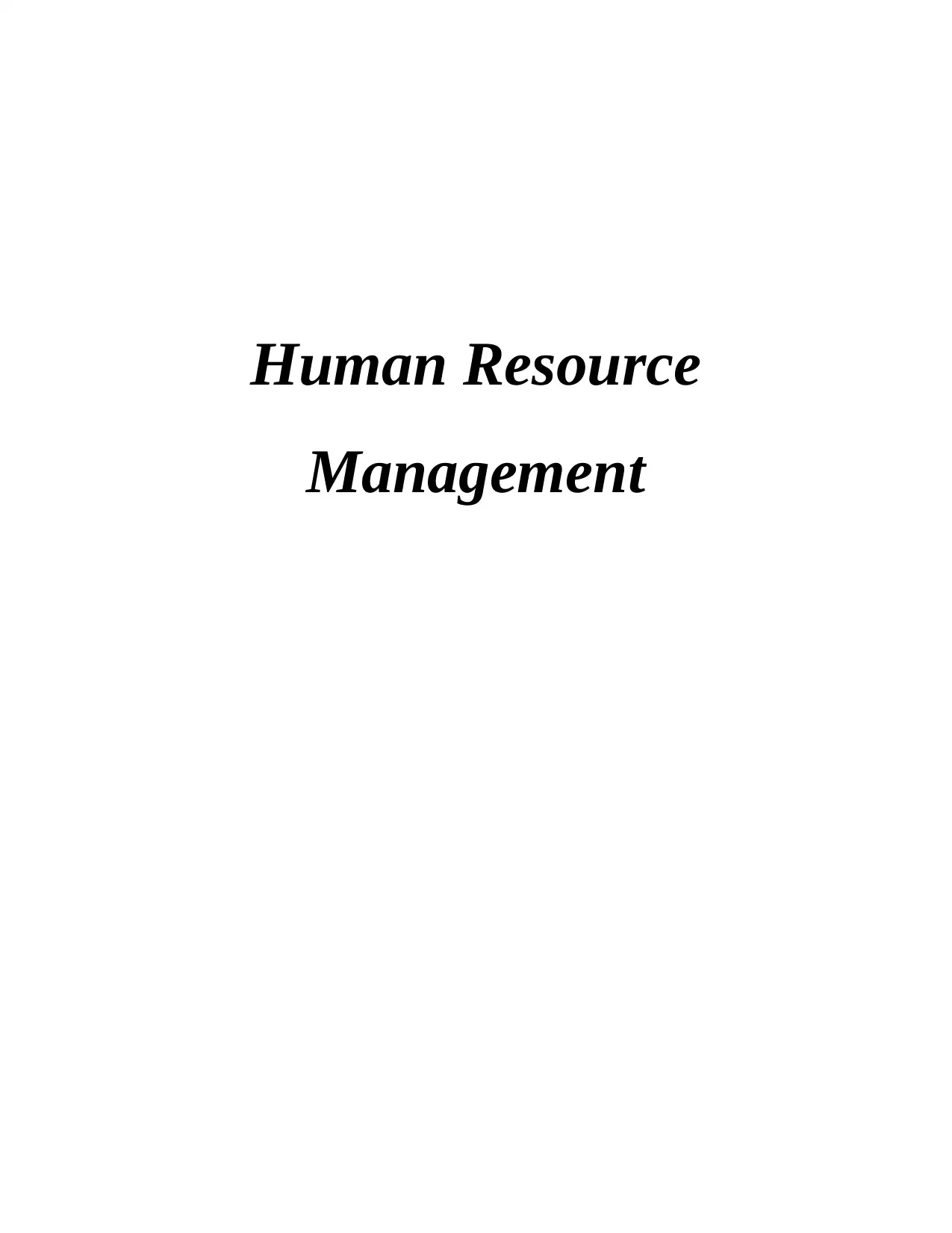
Human Resource
Management
Management
Secure Best Marks with AI Grader
Need help grading? Try our AI Grader for instant feedback on your assignments.
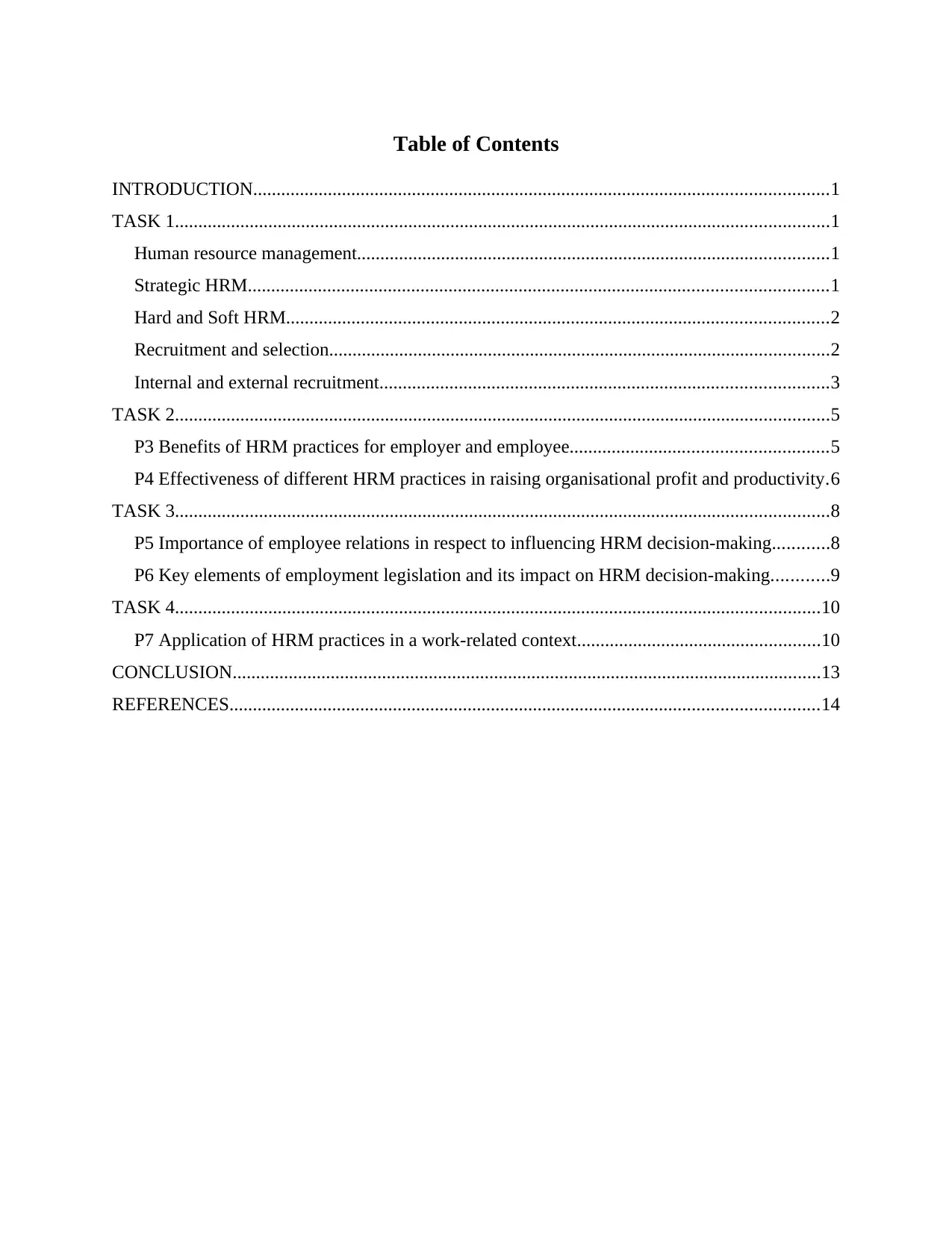
Table of Contents
INTRODUCTION...........................................................................................................................1
TASK 1............................................................................................................................................1
Human resource management.....................................................................................................1
Strategic HRM............................................................................................................................1
Hard and Soft HRM....................................................................................................................2
Recruitment and selection...........................................................................................................2
Internal and external recruitment................................................................................................3
TASK 2............................................................................................................................................5
P3 Benefits of HRM practices for employer and employee.......................................................5
P4 Effectiveness of different HRM practices in raising organisational profit and productivity.6
TASK 3............................................................................................................................................8
P5 Importance of employee relations in respect to influencing HRM decision-making............8
P6 Key elements of employment legislation and its impact on HRM decision-making............9
TASK 4..........................................................................................................................................10
P7 Application of HRM practices in a work-related context....................................................10
CONCLUSION..............................................................................................................................13
REFERENCES..............................................................................................................................14
INTRODUCTION...........................................................................................................................1
TASK 1............................................................................................................................................1
Human resource management.....................................................................................................1
Strategic HRM............................................................................................................................1
Hard and Soft HRM....................................................................................................................2
Recruitment and selection...........................................................................................................2
Internal and external recruitment................................................................................................3
TASK 2............................................................................................................................................5
P3 Benefits of HRM practices for employer and employee.......................................................5
P4 Effectiveness of different HRM practices in raising organisational profit and productivity.6
TASK 3............................................................................................................................................8
P5 Importance of employee relations in respect to influencing HRM decision-making............8
P6 Key elements of employment legislation and its impact on HRM decision-making............9
TASK 4..........................................................................................................................................10
P7 Application of HRM practices in a work-related context....................................................10
CONCLUSION..............................................................................................................................13
REFERENCES..............................................................................................................................14

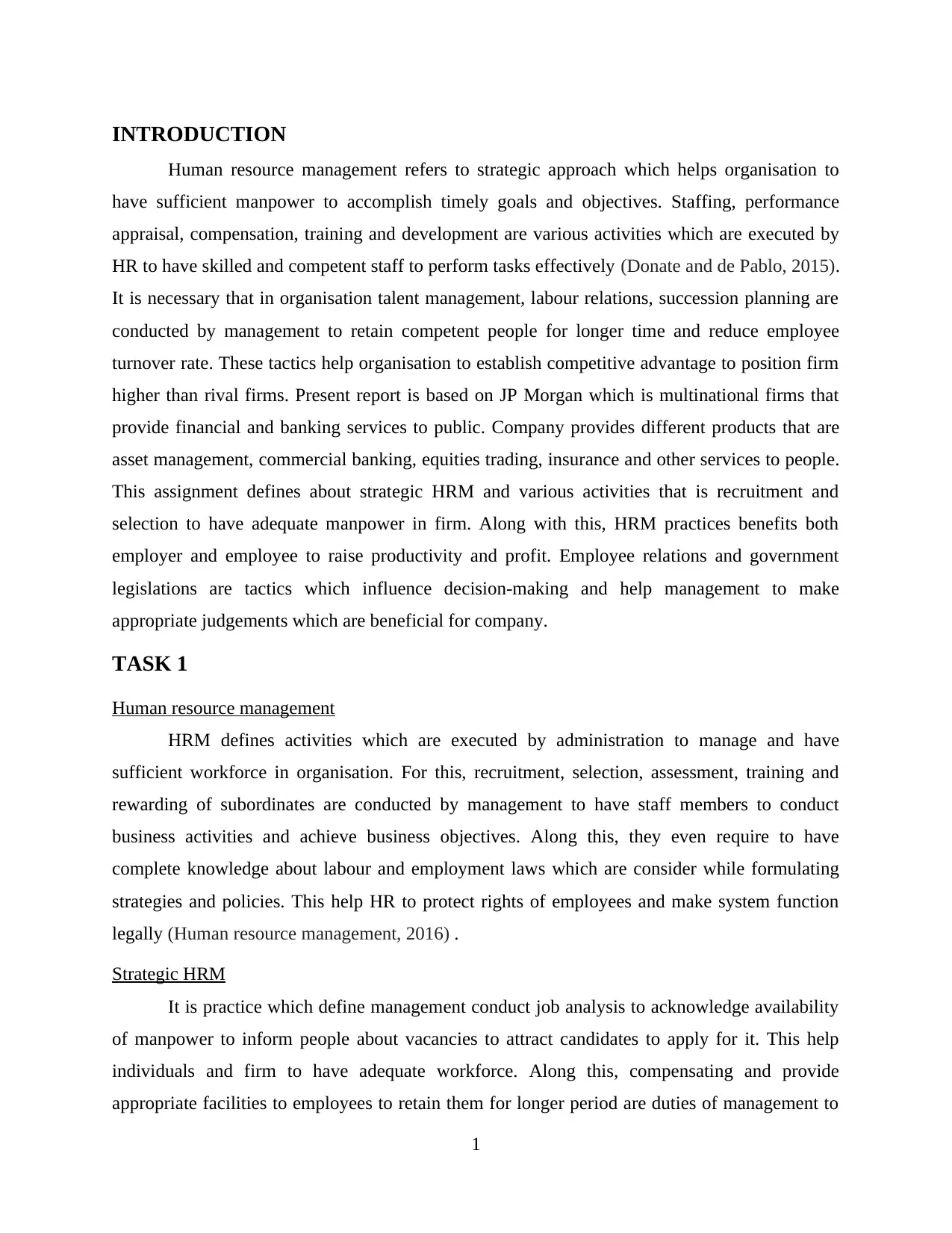
INTRODUCTION
Human resource management refers to strategic approach which helps organisation to
have sufficient manpower to accomplish timely goals and objectives. Staffing, performance
appraisal, compensation, training and development are various activities which are executed by
HR to have skilled and competent staff to perform tasks effectively (Donate and de Pablo, 2015).
It is necessary that in organisation talent management, labour relations, succession planning are
conducted by management to retain competent people for longer time and reduce employee
turnover rate. These tactics help organisation to establish competitive advantage to position firm
higher than rival firms. Present report is based on JP Morgan which is multinational firms that
provide financial and banking services to public. Company provides different products that are
asset management, commercial banking, equities trading, insurance and other services to people.
This assignment defines about strategic HRM and various activities that is recruitment and
selection to have adequate manpower in firm. Along with this, HRM practices benefits both
employer and employee to raise productivity and profit. Employee relations and government
legislations are tactics which influence decision-making and help management to make
appropriate judgements which are beneficial for company.
TASK 1
Human resource management
HRM defines activities which are executed by administration to manage and have
sufficient workforce in organisation. For this, recruitment, selection, assessment, training and
rewarding of subordinates are conducted by management to have staff members to conduct
business activities and achieve business objectives. Along this, they even require to have
complete knowledge about labour and employment laws which are consider while formulating
strategies and policies. This help HR to protect rights of employees and make system function
legally (Human resource management, 2016) .
Strategic HRM
It is practice which define management conduct job analysis to acknowledge availability
of manpower to inform people about vacancies to attract candidates to apply for it. This help
individuals and firm to have adequate workforce. Along this, compensating and provide
appropriate facilities to employees to retain them for longer period are duties of management to
1
Human resource management refers to strategic approach which helps organisation to
have sufficient manpower to accomplish timely goals and objectives. Staffing, performance
appraisal, compensation, training and development are various activities which are executed by
HR to have skilled and competent staff to perform tasks effectively (Donate and de Pablo, 2015).
It is necessary that in organisation talent management, labour relations, succession planning are
conducted by management to retain competent people for longer time and reduce employee
turnover rate. These tactics help organisation to establish competitive advantage to position firm
higher than rival firms. Present report is based on JP Morgan which is multinational firms that
provide financial and banking services to public. Company provides different products that are
asset management, commercial banking, equities trading, insurance and other services to people.
This assignment defines about strategic HRM and various activities that is recruitment and
selection to have adequate manpower in firm. Along with this, HRM practices benefits both
employer and employee to raise productivity and profit. Employee relations and government
legislations are tactics which influence decision-making and help management to make
appropriate judgements which are beneficial for company.
TASK 1
Human resource management
HRM defines activities which are executed by administration to manage and have
sufficient workforce in organisation. For this, recruitment, selection, assessment, training and
rewarding of subordinates are conducted by management to have staff members to conduct
business activities and achieve business objectives. Along this, they even require to have
complete knowledge about labour and employment laws which are consider while formulating
strategies and policies. This help HR to protect rights of employees and make system function
legally (Human resource management, 2016) .
Strategic HRM
It is practice which define management conduct job analysis to acknowledge availability
of manpower to inform people about vacancies to attract candidates to apply for it. This help
individuals and firm to have adequate workforce. Along this, compensating and provide
appropriate facilities to employees to retain them for longer period are duties of management to
1
Secure Best Marks with AI Grader
Need help grading? Try our AI Grader for instant feedback on your assignments.
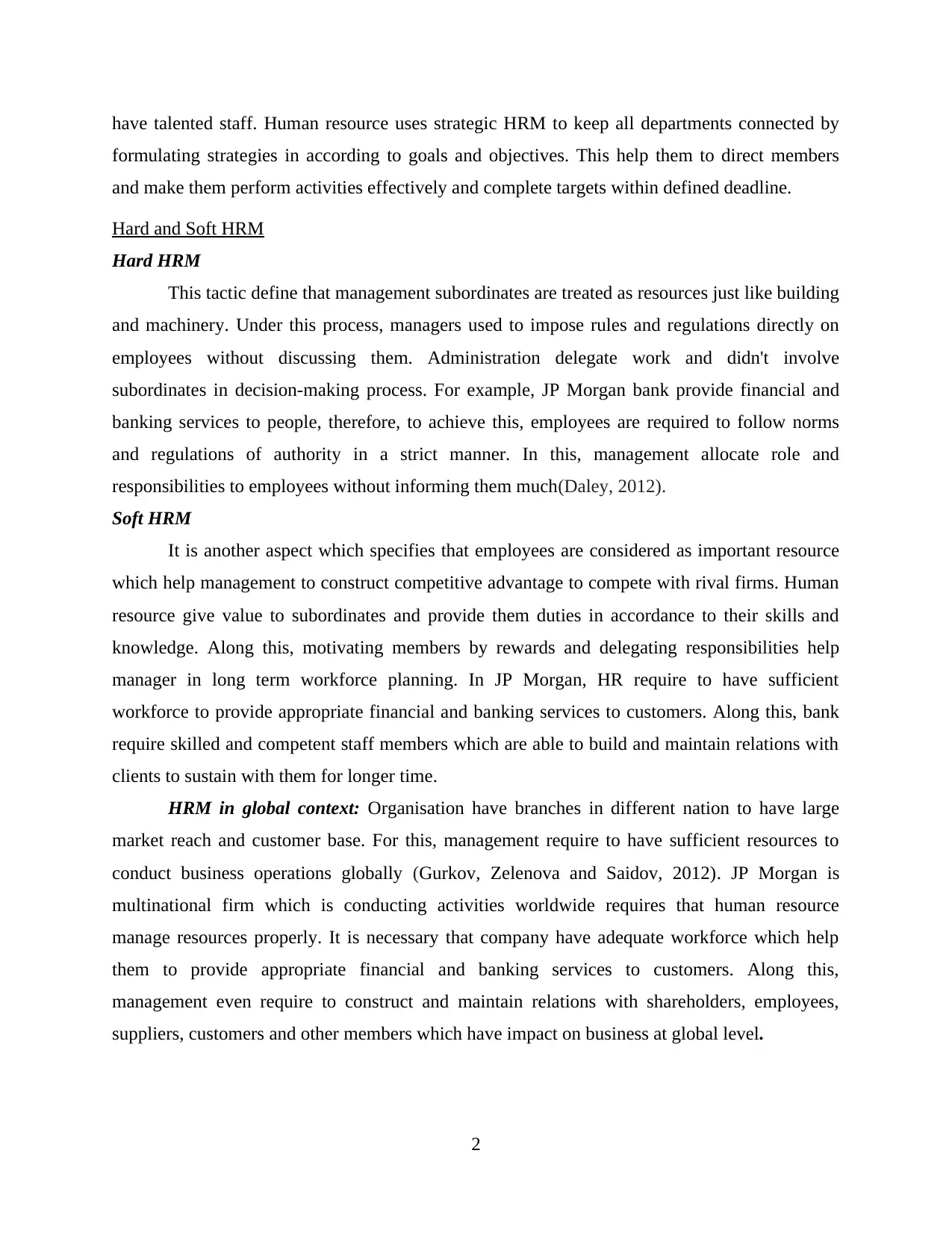
have talented staff. Human resource uses strategic HRM to keep all departments connected by
formulating strategies in according to goals and objectives. This help them to direct members
and make them perform activities effectively and complete targets within defined deadline.
Hard and Soft HRM
Hard HRM
This tactic define that management subordinates are treated as resources just like building
and machinery. Under this process, managers used to impose rules and regulations directly on
employees without discussing them. Administration delegate work and didn't involve
subordinates in decision-making process. For example, JP Morgan bank provide financial and
banking services to people, therefore, to achieve this, employees are required to follow norms
and regulations of authority in a strict manner. In this, management allocate role and
responsibilities to employees without informing them much(Daley, 2012).
Soft HRM
It is another aspect which specifies that employees are considered as important resource
which help management to construct competitive advantage to compete with rival firms. Human
resource give value to subordinates and provide them duties in accordance to their skills and
knowledge. Along this, motivating members by rewards and delegating responsibilities help
manager in long term workforce planning. In JP Morgan, HR require to have sufficient
workforce to provide appropriate financial and banking services to customers. Along this, bank
require skilled and competent staff members which are able to build and maintain relations with
clients to sustain with them for longer time.
HRM in global context: Organisation have branches in different nation to have large
market reach and customer base. For this, management require to have sufficient resources to
conduct business operations globally (Gurkov, Zelenova and Saidov, 2012). JP Morgan is
multinational firm which is conducting activities worldwide requires that human resource
manage resources properly. It is necessary that company have adequate workforce which help
them to provide appropriate financial and banking services to customers. Along this,
management even require to construct and maintain relations with shareholders, employees,
suppliers, customers and other members which have impact on business at global level.
2
formulating strategies in according to goals and objectives. This help them to direct members
and make them perform activities effectively and complete targets within defined deadline.
Hard and Soft HRM
Hard HRM
This tactic define that management subordinates are treated as resources just like building
and machinery. Under this process, managers used to impose rules and regulations directly on
employees without discussing them. Administration delegate work and didn't involve
subordinates in decision-making process. For example, JP Morgan bank provide financial and
banking services to people, therefore, to achieve this, employees are required to follow norms
and regulations of authority in a strict manner. In this, management allocate role and
responsibilities to employees without informing them much(Daley, 2012).
Soft HRM
It is another aspect which specifies that employees are considered as important resource
which help management to construct competitive advantage to compete with rival firms. Human
resource give value to subordinates and provide them duties in accordance to their skills and
knowledge. Along this, motivating members by rewards and delegating responsibilities help
manager in long term workforce planning. In JP Morgan, HR require to have sufficient
workforce to provide appropriate financial and banking services to customers. Along this, bank
require skilled and competent staff members which are able to build and maintain relations with
clients to sustain with them for longer time.
HRM in global context: Organisation have branches in different nation to have large
market reach and customer base. For this, management require to have sufficient resources to
conduct business operations globally (Gurkov, Zelenova and Saidov, 2012). JP Morgan is
multinational firm which is conducting activities worldwide requires that human resource
manage resources properly. It is necessary that company have adequate workforce which help
them to provide appropriate financial and banking services to customers. Along this,
management even require to construct and maintain relations with shareholders, employees,
suppliers, customers and other members which have impact on business at global level.
2
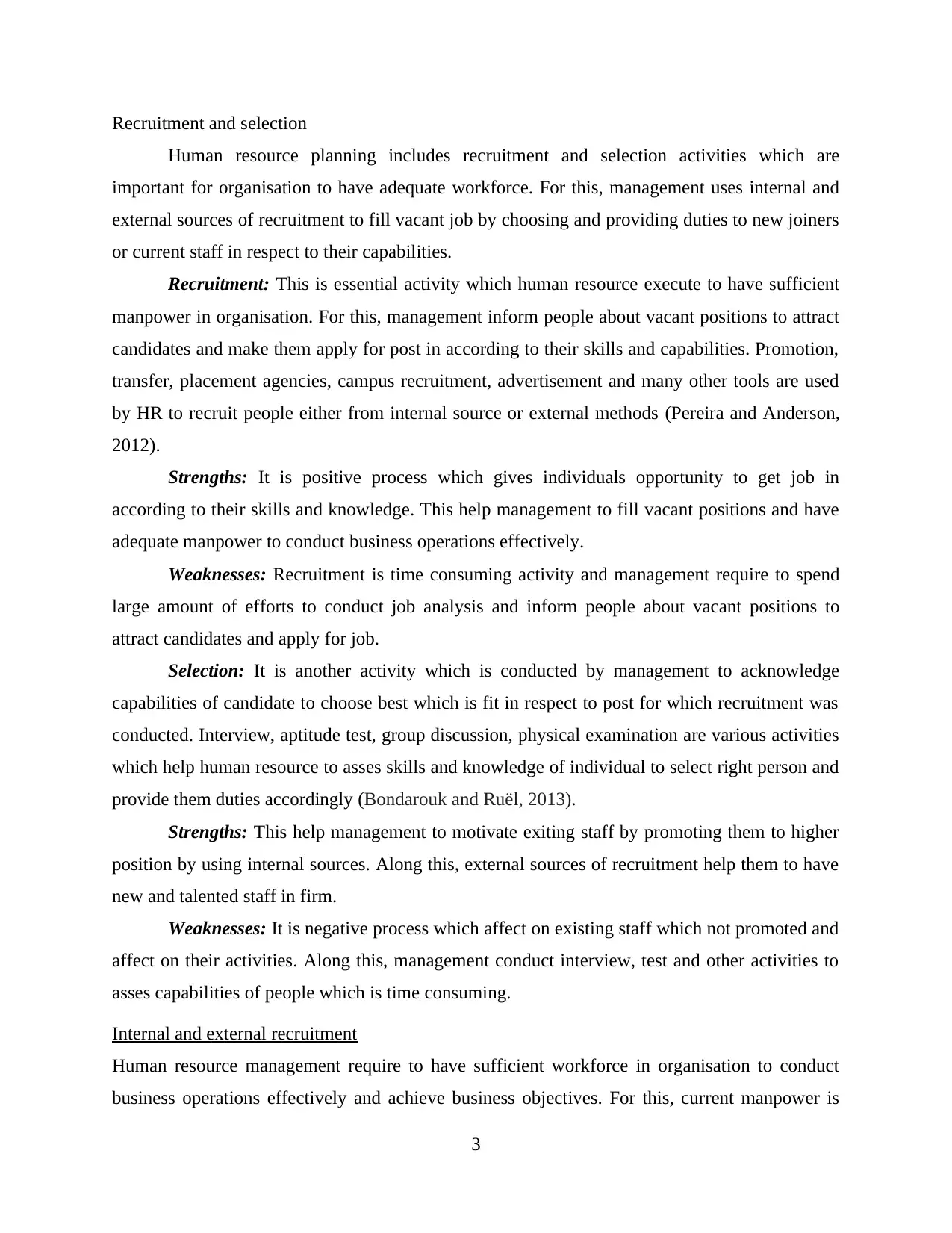
Recruitment and selection
Human resource planning includes recruitment and selection activities which are
important for organisation to have adequate workforce. For this, management uses internal and
external sources of recruitment to fill vacant job by choosing and providing duties to new joiners
or current staff in respect to their capabilities.
Recruitment: This is essential activity which human resource execute to have sufficient
manpower in organisation. For this, management inform people about vacant positions to attract
candidates and make them apply for post in according to their skills and capabilities. Promotion,
transfer, placement agencies, campus recruitment, advertisement and many other tools are used
by HR to recruit people either from internal source or external methods (Pereira and Anderson,
2012).
Strengths: It is positive process which gives individuals opportunity to get job in
according to their skills and knowledge. This help management to fill vacant positions and have
adequate manpower to conduct business operations effectively.
Weaknesses: Recruitment is time consuming activity and management require to spend
large amount of efforts to conduct job analysis and inform people about vacant positions to
attract candidates and apply for job.
Selection: It is another activity which is conducted by management to acknowledge
capabilities of candidate to choose best which is fit in respect to post for which recruitment was
conducted. Interview, aptitude test, group discussion, physical examination are various activities
which help human resource to asses skills and knowledge of individual to select right person and
provide them duties accordingly (Bondarouk and Ruël, 2013).
Strengths: This help management to motivate exiting staff by promoting them to higher
position by using internal sources. Along this, external sources of recruitment help them to have
new and talented staff in firm.
Weaknesses: It is negative process which affect on existing staff which not promoted and
affect on their activities. Along this, management conduct interview, test and other activities to
asses capabilities of people which is time consuming.
Internal and external recruitment
Human resource management require to have sufficient workforce in organisation to conduct
business operations effectively and achieve business objectives. For this, current manpower is
3
Human resource planning includes recruitment and selection activities which are
important for organisation to have adequate workforce. For this, management uses internal and
external sources of recruitment to fill vacant job by choosing and providing duties to new joiners
or current staff in respect to their capabilities.
Recruitment: This is essential activity which human resource execute to have sufficient
manpower in organisation. For this, management inform people about vacant positions to attract
candidates and make them apply for post in according to their skills and capabilities. Promotion,
transfer, placement agencies, campus recruitment, advertisement and many other tools are used
by HR to recruit people either from internal source or external methods (Pereira and Anderson,
2012).
Strengths: It is positive process which gives individuals opportunity to get job in
according to their skills and knowledge. This help management to fill vacant positions and have
adequate manpower to conduct business operations effectively.
Weaknesses: Recruitment is time consuming activity and management require to spend
large amount of efforts to conduct job analysis and inform people about vacant positions to
attract candidates and apply for job.
Selection: It is another activity which is conducted by management to acknowledge
capabilities of candidate to choose best which is fit in respect to post for which recruitment was
conducted. Interview, aptitude test, group discussion, physical examination are various activities
which help human resource to asses skills and knowledge of individual to select right person and
provide them duties accordingly (Bondarouk and Ruël, 2013).
Strengths: This help management to motivate exiting staff by promoting them to higher
position by using internal sources. Along this, external sources of recruitment help them to have
new and talented staff in firm.
Weaknesses: It is negative process which affect on existing staff which not promoted and
affect on their activities. Along this, management conduct interview, test and other activities to
asses capabilities of people which is time consuming.
Internal and external recruitment
Human resource management require to have sufficient workforce in organisation to conduct
business operations effectively and achieve business objectives. For this, current manpower is
3
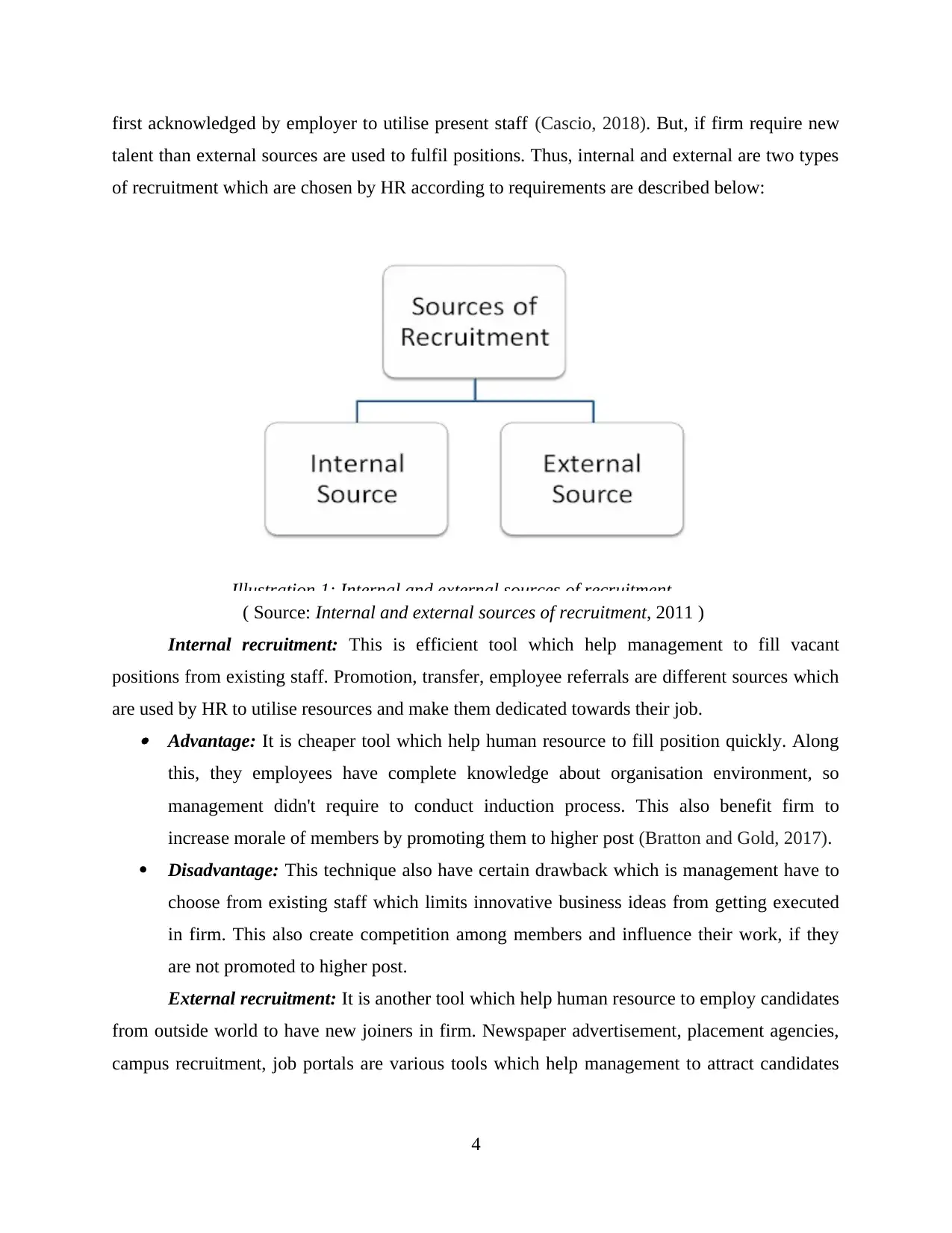
first acknowledged by employer to utilise present staff (Cascio, 2018). But, if firm require new
talent than external sources are used to fulfil positions. Thus, internal and external are two types
of recruitment which are chosen by HR according to requirements are described below:
( Source: Internal and external sources of recruitment, 2011 )
Internal recruitment: This is efficient tool which help management to fill vacant
positions from existing staff. Promotion, transfer, employee referrals are different sources which
are used by HR to utilise resources and make them dedicated towards their job. Advantage: It is cheaper tool which help human resource to fill position quickly. Along
this, they employees have complete knowledge about organisation environment, so
management didn't require to conduct induction process. This also benefit firm to
increase morale of members by promoting them to higher post (Bratton and Gold, 2017).
Disadvantage: This technique also have certain drawback which is management have to
choose from existing staff which limits innovative business ideas from getting executed
in firm. This also create competition among members and influence their work, if they
are not promoted to higher post.
External recruitment: It is another tool which help human resource to employ candidates
from outside world to have new joiners in firm. Newspaper advertisement, placement agencies,
campus recruitment, job portals are various tools which help management to attract candidates
4
Illustration 1: Internal and external sources of recruitment
talent than external sources are used to fulfil positions. Thus, internal and external are two types
of recruitment which are chosen by HR according to requirements are described below:
( Source: Internal and external sources of recruitment, 2011 )
Internal recruitment: This is efficient tool which help management to fill vacant
positions from existing staff. Promotion, transfer, employee referrals are different sources which
are used by HR to utilise resources and make them dedicated towards their job. Advantage: It is cheaper tool which help human resource to fill position quickly. Along
this, they employees have complete knowledge about organisation environment, so
management didn't require to conduct induction process. This also benefit firm to
increase morale of members by promoting them to higher post (Bratton and Gold, 2017).
Disadvantage: This technique also have certain drawback which is management have to
choose from existing staff which limits innovative business ideas from getting executed
in firm. This also create competition among members and influence their work, if they
are not promoted to higher post.
External recruitment: It is another tool which help human resource to employ candidates
from outside world to have new joiners in firm. Newspaper advertisement, placement agencies,
campus recruitment, job portals are various tools which help management to attract candidates
4
Illustration 1: Internal and external sources of recruitment
Paraphrase This Document
Need a fresh take? Get an instant paraphrase of this document with our AI Paraphraser
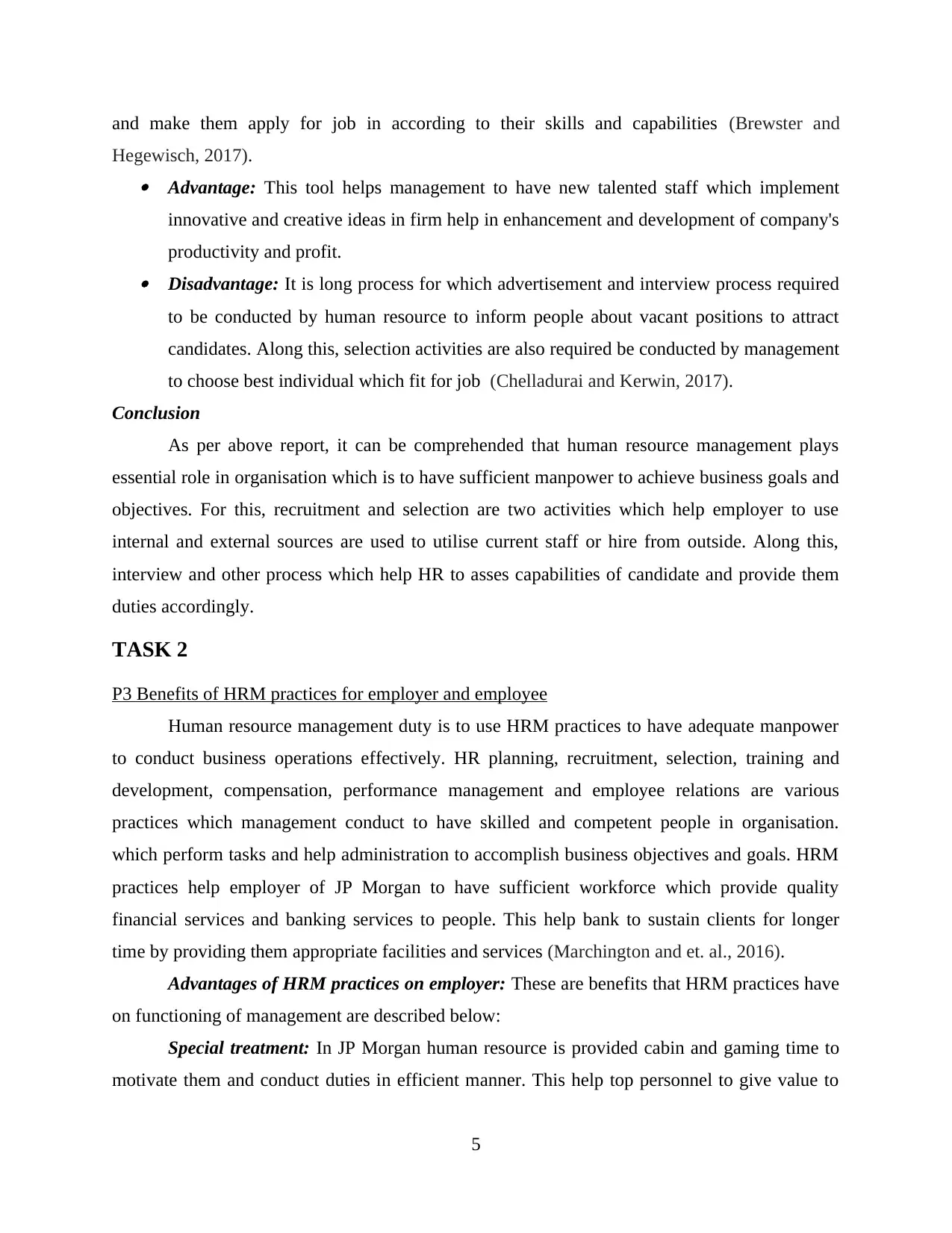
and make them apply for job in according to their skills and capabilities (Brewster and
Hegewisch, 2017). Advantage: This tool helps management to have new talented staff which implement
innovative and creative ideas in firm help in enhancement and development of company's
productivity and profit. Disadvantage: It is long process for which advertisement and interview process required
to be conducted by human resource to inform people about vacant positions to attract
candidates. Along this, selection activities are also required be conducted by management
to choose best individual which fit for job (Chelladurai and Kerwin, 2017).
Conclusion
As per above report, it can be comprehended that human resource management plays
essential role in organisation which is to have sufficient manpower to achieve business goals and
objectives. For this, recruitment and selection are two activities which help employer to use
internal and external sources are used to utilise current staff or hire from outside. Along this,
interview and other process which help HR to asses capabilities of candidate and provide them
duties accordingly.
TASK 2
P3 Benefits of HRM practices for employer and employee
Human resource management duty is to use HRM practices to have adequate manpower
to conduct business operations effectively. HR planning, recruitment, selection, training and
development, compensation, performance management and employee relations are various
practices which management conduct to have skilled and competent people in organisation.
which perform tasks and help administration to accomplish business objectives and goals. HRM
practices help employer of JP Morgan to have sufficient workforce which provide quality
financial services and banking services to people. This help bank to sustain clients for longer
time by providing them appropriate facilities and services (Marchington and et. al., 2016).
Advantages of HRM practices on employer: These are benefits that HRM practices have
on functioning of management are described below:
Special treatment: In JP Morgan human resource is provided cabin and gaming time to
motivate them and conduct duties in efficient manner. This help top personnel to give value to
5
Hegewisch, 2017). Advantage: This tool helps management to have new talented staff which implement
innovative and creative ideas in firm help in enhancement and development of company's
productivity and profit. Disadvantage: It is long process for which advertisement and interview process required
to be conducted by human resource to inform people about vacant positions to attract
candidates. Along this, selection activities are also required be conducted by management
to choose best individual which fit for job (Chelladurai and Kerwin, 2017).
Conclusion
As per above report, it can be comprehended that human resource management plays
essential role in organisation which is to have sufficient manpower to achieve business goals and
objectives. For this, recruitment and selection are two activities which help employer to use
internal and external sources are used to utilise current staff or hire from outside. Along this,
interview and other process which help HR to asses capabilities of candidate and provide them
duties accordingly.
TASK 2
P3 Benefits of HRM practices for employer and employee
Human resource management duty is to use HRM practices to have adequate manpower
to conduct business operations effectively. HR planning, recruitment, selection, training and
development, compensation, performance management and employee relations are various
practices which management conduct to have skilled and competent people in organisation.
which perform tasks and help administration to accomplish business objectives and goals. HRM
practices help employer of JP Morgan to have sufficient workforce which provide quality
financial services and banking services to people. This help bank to sustain clients for longer
time by providing them appropriate facilities and services (Marchington and et. al., 2016).
Advantages of HRM practices on employer: These are benefits that HRM practices have
on functioning of management are described below:
Special treatment: In JP Morgan human resource is provided cabin and gaming time to
motivate them and conduct duties in efficient manner. This help top personnel to give value to
5
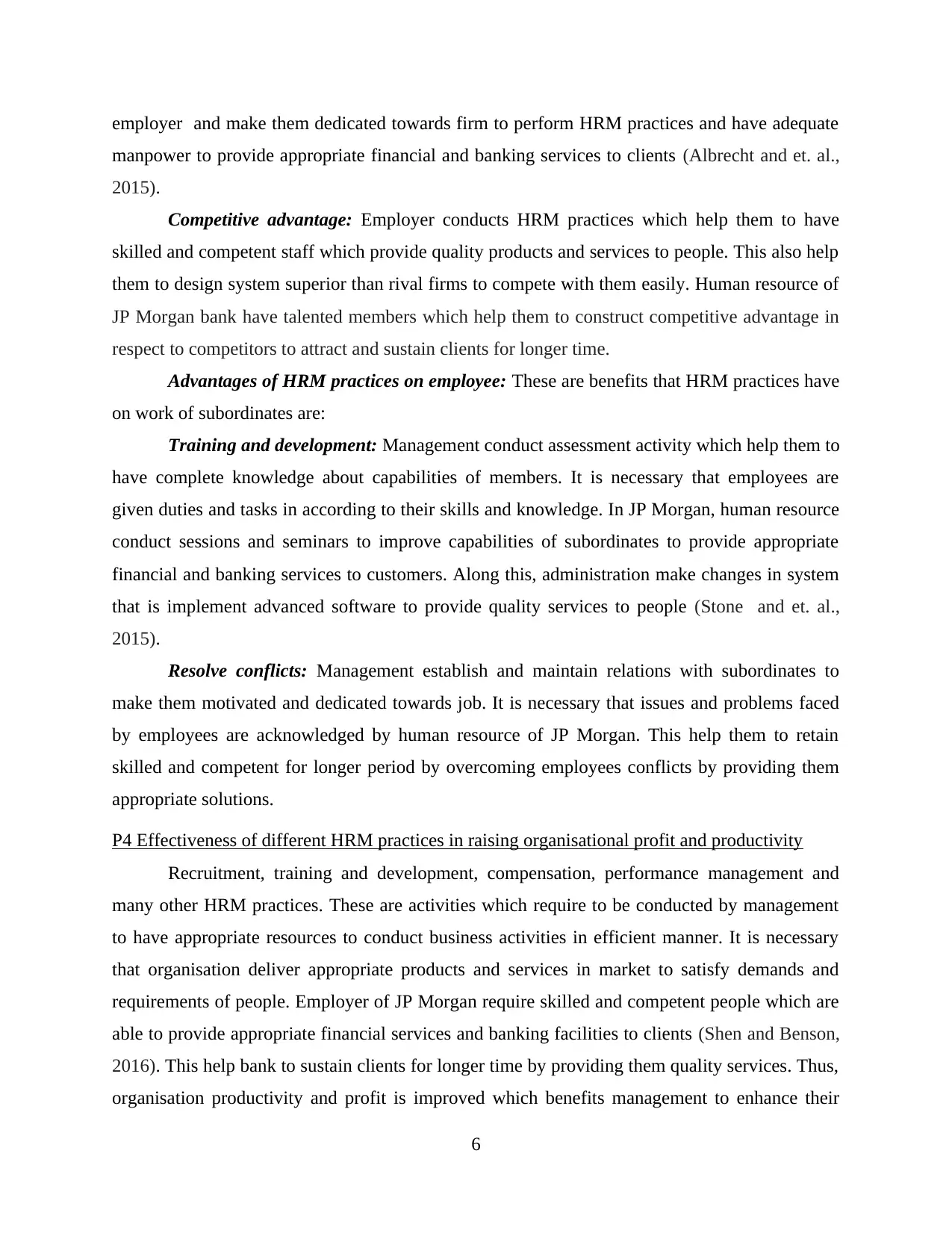
employer and make them dedicated towards firm to perform HRM practices and have adequate
manpower to provide appropriate financial and banking services to clients (Albrecht and et. al.,
2015).
Competitive advantage: Employer conducts HRM practices which help them to have
skilled and competent staff which provide quality products and services to people. This also help
them to design system superior than rival firms to compete with them easily. Human resource of
JP Morgan bank have talented members which help them to construct competitive advantage in
respect to competitors to attract and sustain clients for longer time.
Advantages of HRM practices on employee: These are benefits that HRM practices have
on work of subordinates are:
Training and development: Management conduct assessment activity which help them to
have complete knowledge about capabilities of members. It is necessary that employees are
given duties and tasks in according to their skills and knowledge. In JP Morgan, human resource
conduct sessions and seminars to improve capabilities of subordinates to provide appropriate
financial and banking services to customers. Along this, administration make changes in system
that is implement advanced software to provide quality services to people (Stone and et. al.,
2015).
Resolve conflicts: Management establish and maintain relations with subordinates to
make them motivated and dedicated towards job. It is necessary that issues and problems faced
by employees are acknowledged by human resource of JP Morgan. This help them to retain
skilled and competent for longer period by overcoming employees conflicts by providing them
appropriate solutions.
P4 Effectiveness of different HRM practices in raising organisational profit and productivity
Recruitment, training and development, compensation, performance management and
many other HRM practices. These are activities which require to be conducted by management
to have appropriate resources to conduct business activities in efficient manner. It is necessary
that organisation deliver appropriate products and services in market to satisfy demands and
requirements of people. Employer of JP Morgan require skilled and competent people which are
able to provide appropriate financial services and banking facilities to clients (Shen and Benson,
2016). This help bank to sustain clients for longer time by providing them quality services. Thus,
organisation productivity and profit is improved which benefits management to enhance their
6
manpower to provide appropriate financial and banking services to clients (Albrecht and et. al.,
2015).
Competitive advantage: Employer conducts HRM practices which help them to have
skilled and competent staff which provide quality products and services to people. This also help
them to design system superior than rival firms to compete with them easily. Human resource of
JP Morgan bank have talented members which help them to construct competitive advantage in
respect to competitors to attract and sustain clients for longer time.
Advantages of HRM practices on employee: These are benefits that HRM practices have
on work of subordinates are:
Training and development: Management conduct assessment activity which help them to
have complete knowledge about capabilities of members. It is necessary that employees are
given duties and tasks in according to their skills and knowledge. In JP Morgan, human resource
conduct sessions and seminars to improve capabilities of subordinates to provide appropriate
financial and banking services to customers. Along this, administration make changes in system
that is implement advanced software to provide quality services to people (Stone and et. al.,
2015).
Resolve conflicts: Management establish and maintain relations with subordinates to
make them motivated and dedicated towards job. It is necessary that issues and problems faced
by employees are acknowledged by human resource of JP Morgan. This help them to retain
skilled and competent for longer period by overcoming employees conflicts by providing them
appropriate solutions.
P4 Effectiveness of different HRM practices in raising organisational profit and productivity
Recruitment, training and development, compensation, performance management and
many other HRM practices. These are activities which require to be conducted by management
to have appropriate resources to conduct business activities in efficient manner. It is necessary
that organisation deliver appropriate products and services in market to satisfy demands and
requirements of people. Employer of JP Morgan require skilled and competent people which are
able to provide appropriate financial services and banking facilities to clients (Shen and Benson,
2016). This help bank to sustain clients for longer time by providing them quality services. Thus,
organisation productivity and profit is improved which benefits management to enhance their
6
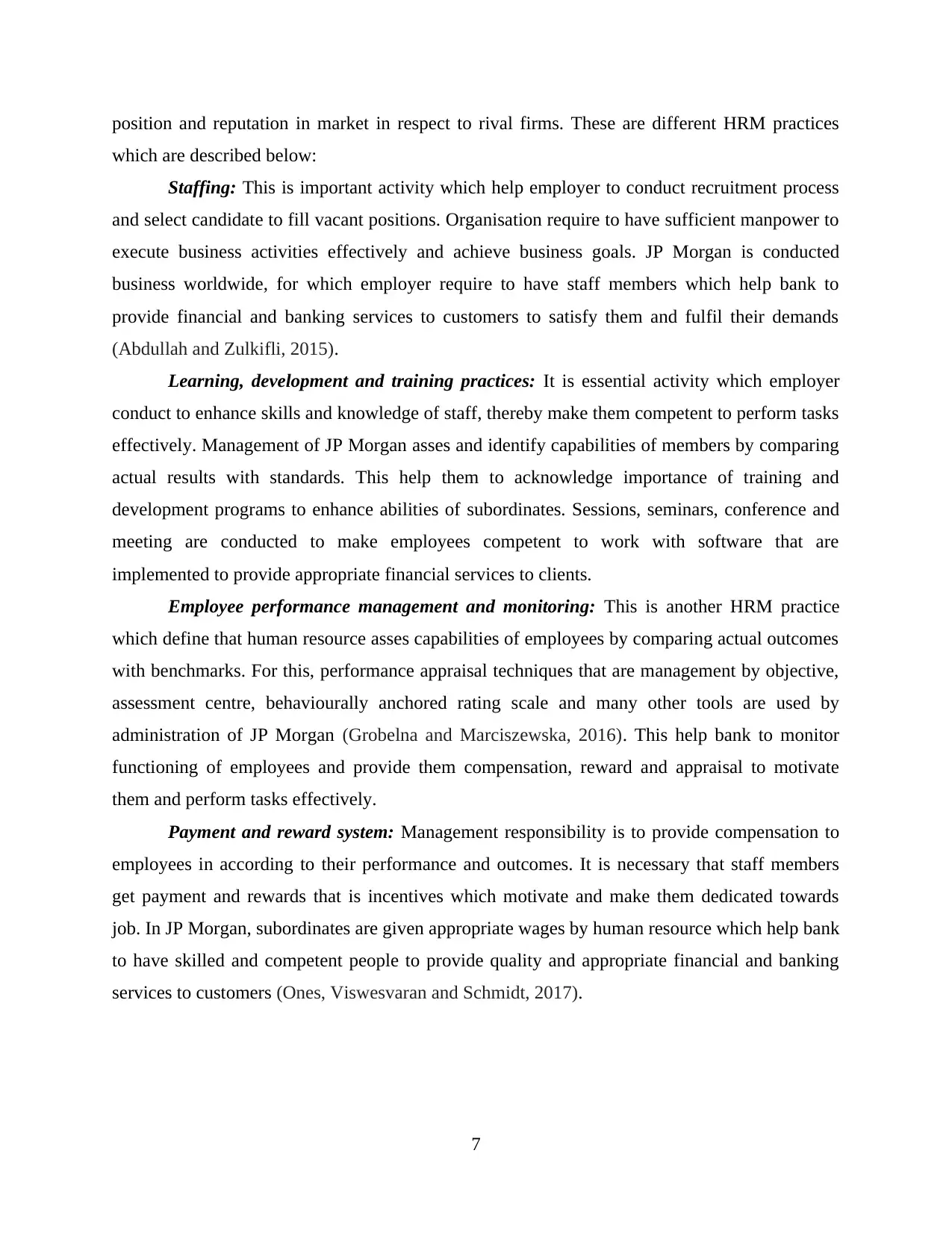
position and reputation in market in respect to rival firms. These are different HRM practices
which are described below:
Staffing: This is important activity which help employer to conduct recruitment process
and select candidate to fill vacant positions. Organisation require to have sufficient manpower to
execute business activities effectively and achieve business goals. JP Morgan is conducted
business worldwide, for which employer require to have staff members which help bank to
provide financial and banking services to customers to satisfy them and fulfil their demands
(Abdullah and Zulkifli, 2015).
Learning, development and training practices: It is essential activity which employer
conduct to enhance skills and knowledge of staff, thereby make them competent to perform tasks
effectively. Management of JP Morgan asses and identify capabilities of members by comparing
actual results with standards. This help them to acknowledge importance of training and
development programs to enhance abilities of subordinates. Sessions, seminars, conference and
meeting are conducted to make employees competent to work with software that are
implemented to provide appropriate financial services to clients.
Employee performance management and monitoring: This is another HRM practice
which define that human resource asses capabilities of employees by comparing actual outcomes
with benchmarks. For this, performance appraisal techniques that are management by objective,
assessment centre, behaviourally anchored rating scale and many other tools are used by
administration of JP Morgan (Grobelna and Marciszewska, 2016). This help bank to monitor
functioning of employees and provide them compensation, reward and appraisal to motivate
them and perform tasks effectively.
Payment and reward system: Management responsibility is to provide compensation to
employees in according to their performance and outcomes. It is necessary that staff members
get payment and rewards that is incentives which motivate and make them dedicated towards
job. In JP Morgan, subordinates are given appropriate wages by human resource which help bank
to have skilled and competent people to provide quality and appropriate financial and banking
services to customers (Ones, Viswesvaran and Schmidt, 2017).
7
which are described below:
Staffing: This is important activity which help employer to conduct recruitment process
and select candidate to fill vacant positions. Organisation require to have sufficient manpower to
execute business activities effectively and achieve business goals. JP Morgan is conducted
business worldwide, for which employer require to have staff members which help bank to
provide financial and banking services to customers to satisfy them and fulfil their demands
(Abdullah and Zulkifli, 2015).
Learning, development and training practices: It is essential activity which employer
conduct to enhance skills and knowledge of staff, thereby make them competent to perform tasks
effectively. Management of JP Morgan asses and identify capabilities of members by comparing
actual results with standards. This help them to acknowledge importance of training and
development programs to enhance abilities of subordinates. Sessions, seminars, conference and
meeting are conducted to make employees competent to work with software that are
implemented to provide appropriate financial services to clients.
Employee performance management and monitoring: This is another HRM practice
which define that human resource asses capabilities of employees by comparing actual outcomes
with benchmarks. For this, performance appraisal techniques that are management by objective,
assessment centre, behaviourally anchored rating scale and many other tools are used by
administration of JP Morgan (Grobelna and Marciszewska, 2016). This help bank to monitor
functioning of employees and provide them compensation, reward and appraisal to motivate
them and perform tasks effectively.
Payment and reward system: Management responsibility is to provide compensation to
employees in according to their performance and outcomes. It is necessary that staff members
get payment and rewards that is incentives which motivate and make them dedicated towards
job. In JP Morgan, subordinates are given appropriate wages by human resource which help bank
to have skilled and competent people to provide quality and appropriate financial and banking
services to customers (Ones, Viswesvaran and Schmidt, 2017).
7
Secure Best Marks with AI Grader
Need help grading? Try our AI Grader for instant feedback on your assignments.
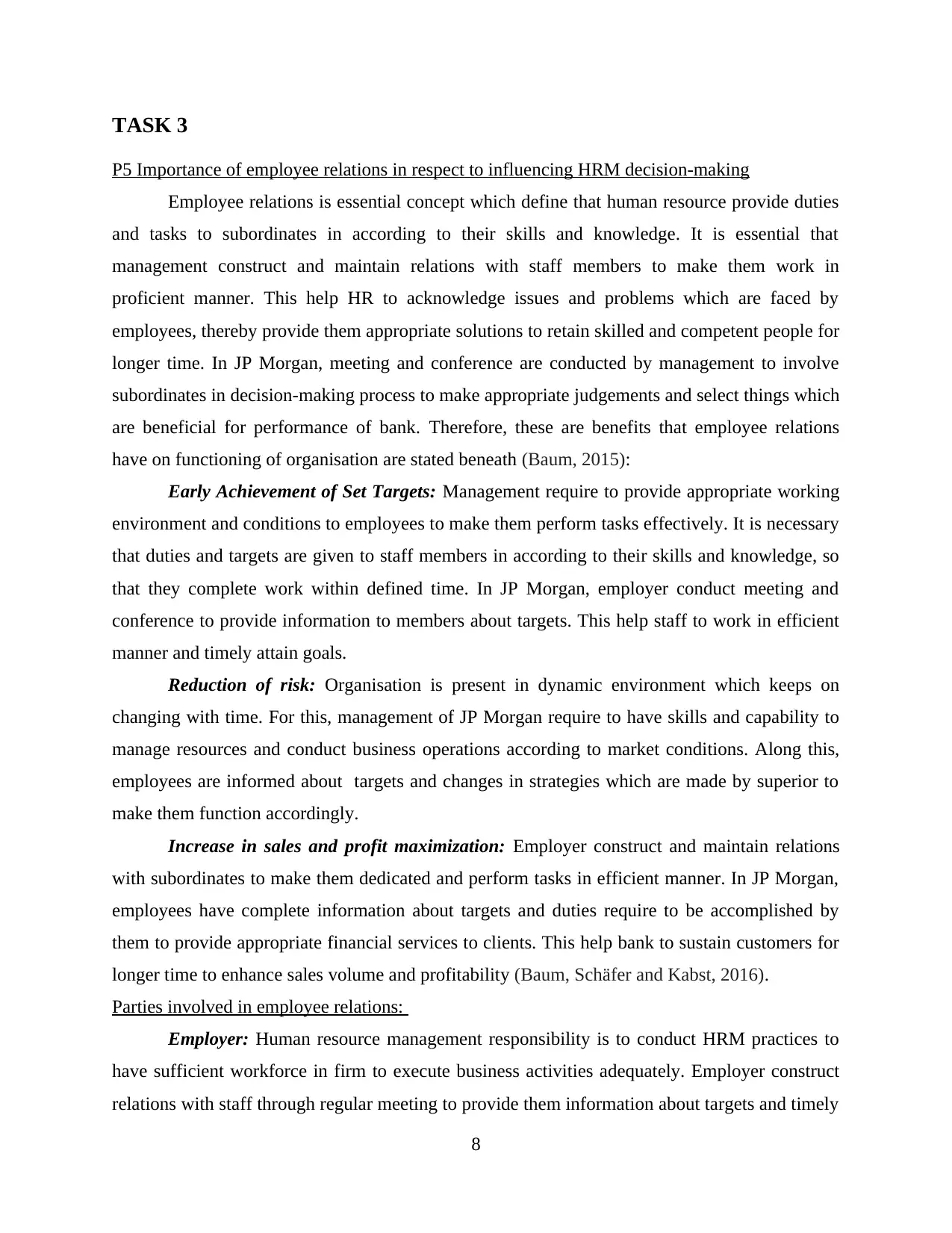
TASK 3
P5 Importance of employee relations in respect to influencing HRM decision-making
Employee relations is essential concept which define that human resource provide duties
and tasks to subordinates in according to their skills and knowledge. It is essential that
management construct and maintain relations with staff members to make them work in
proficient manner. This help HR to acknowledge issues and problems which are faced by
employees, thereby provide them appropriate solutions to retain skilled and competent people for
longer time. In JP Morgan, meeting and conference are conducted by management to involve
subordinates in decision-making process to make appropriate judgements and select things which
are beneficial for performance of bank. Therefore, these are benefits that employee relations
have on functioning of organisation are stated beneath (Baum, 2015):
Early Achievement of Set Targets: Management require to provide appropriate working
environment and conditions to employees to make them perform tasks effectively. It is necessary
that duties and targets are given to staff members in according to their skills and knowledge, so
that they complete work within defined time. In JP Morgan, employer conduct meeting and
conference to provide information to members about targets. This help staff to work in efficient
manner and timely attain goals.
Reduction of risk: Organisation is present in dynamic environment which keeps on
changing with time. For this, management of JP Morgan require to have skills and capability to
manage resources and conduct business operations according to market conditions. Along this,
employees are informed about targets and changes in strategies which are made by superior to
make them function accordingly.
Increase in sales and profit maximization: Employer construct and maintain relations
with subordinates to make them dedicated and perform tasks in efficient manner. In JP Morgan,
employees have complete information about targets and duties require to be accomplished by
them to provide appropriate financial services to clients. This help bank to sustain customers for
longer time to enhance sales volume and profitability (Baum, Schäfer and Kabst, 2016).
Parties involved in employee relations:
Employer: Human resource management responsibility is to conduct HRM practices to
have sufficient workforce in firm to execute business activities adequately. Employer construct
relations with staff through regular meeting to provide them information about targets and timely
8
P5 Importance of employee relations in respect to influencing HRM decision-making
Employee relations is essential concept which define that human resource provide duties
and tasks to subordinates in according to their skills and knowledge. It is essential that
management construct and maintain relations with staff members to make them work in
proficient manner. This help HR to acknowledge issues and problems which are faced by
employees, thereby provide them appropriate solutions to retain skilled and competent people for
longer time. In JP Morgan, meeting and conference are conducted by management to involve
subordinates in decision-making process to make appropriate judgements and select things which
are beneficial for performance of bank. Therefore, these are benefits that employee relations
have on functioning of organisation are stated beneath (Baum, 2015):
Early Achievement of Set Targets: Management require to provide appropriate working
environment and conditions to employees to make them perform tasks effectively. It is necessary
that duties and targets are given to staff members in according to their skills and knowledge, so
that they complete work within defined time. In JP Morgan, employer conduct meeting and
conference to provide information to members about targets. This help staff to work in efficient
manner and timely attain goals.
Reduction of risk: Organisation is present in dynamic environment which keeps on
changing with time. For this, management of JP Morgan require to have skills and capability to
manage resources and conduct business operations according to market conditions. Along this,
employees are informed about targets and changes in strategies which are made by superior to
make them function accordingly.
Increase in sales and profit maximization: Employer construct and maintain relations
with subordinates to make them dedicated and perform tasks in efficient manner. In JP Morgan,
employees have complete information about targets and duties require to be accomplished by
them to provide appropriate financial services to clients. This help bank to sustain customers for
longer time to enhance sales volume and profitability (Baum, Schäfer and Kabst, 2016).
Parties involved in employee relations:
Employer: Human resource management responsibility is to conduct HRM practices to
have sufficient workforce in firm to execute business activities adequately. Employer construct
relations with staff through regular meeting to provide them information about targets and timely
8
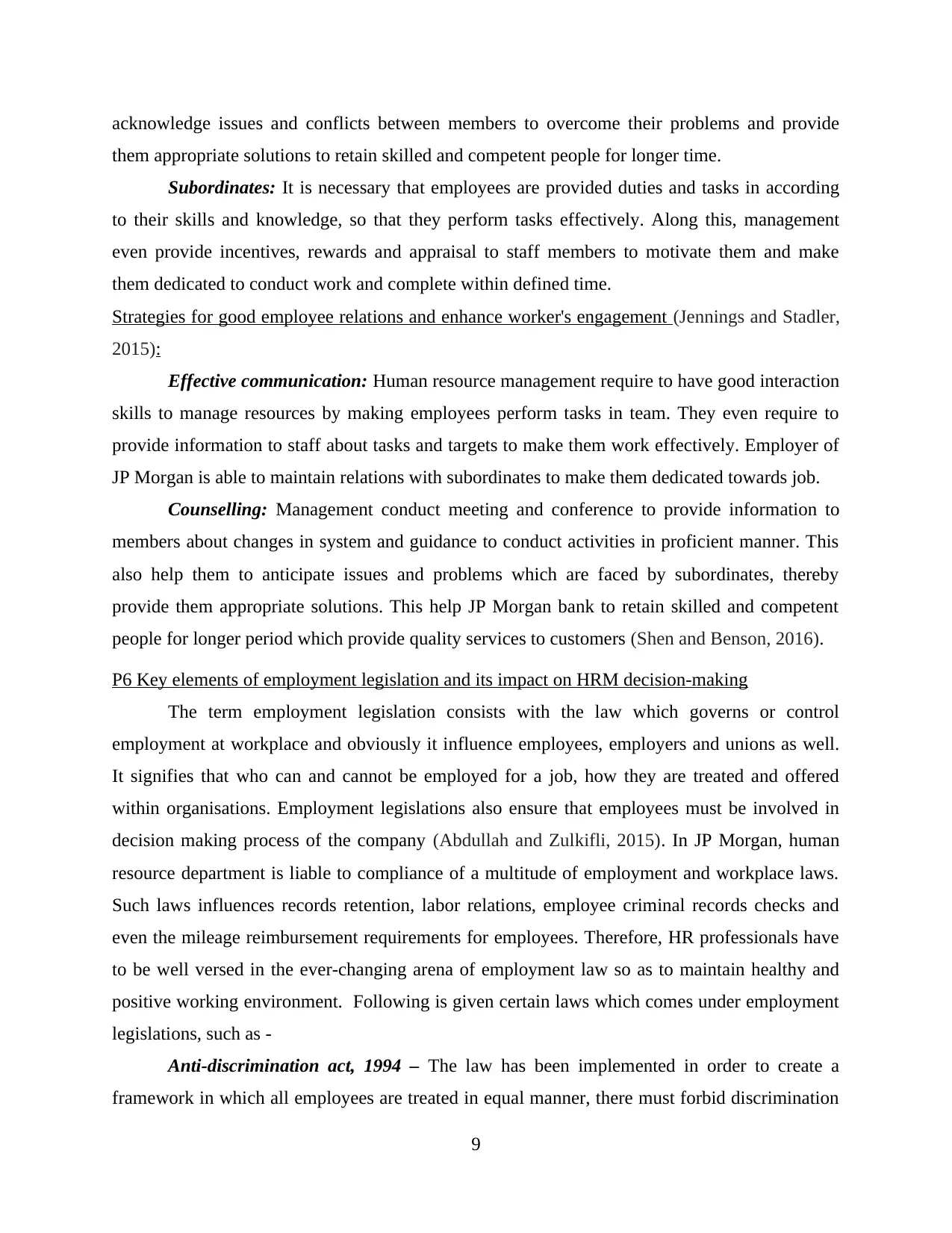
acknowledge issues and conflicts between members to overcome their problems and provide
them appropriate solutions to retain skilled and competent people for longer time.
Subordinates: It is necessary that employees are provided duties and tasks in according
to their skills and knowledge, so that they perform tasks effectively. Along this, management
even provide incentives, rewards and appraisal to staff members to motivate them and make
them dedicated to conduct work and complete within defined time.
Strategies for good employee relations and enhance worker's engagement (Jennings and Stadler,
2015):
Effective communication: Human resource management require to have good interaction
skills to manage resources by making employees perform tasks in team. They even require to
provide information to staff about tasks and targets to make them work effectively. Employer of
JP Morgan is able to maintain relations with subordinates to make them dedicated towards job.
Counselling: Management conduct meeting and conference to provide information to
members about changes in system and guidance to conduct activities in proficient manner. This
also help them to anticipate issues and problems which are faced by subordinates, thereby
provide them appropriate solutions. This help JP Morgan bank to retain skilled and competent
people for longer period which provide quality services to customers (Shen and Benson, 2016).
P6 Key elements of employment legislation and its impact on HRM decision-making
The term employment legislation consists with the law which governs or control
employment at workplace and obviously it influence employees, employers and unions as well.
It signifies that who can and cannot be employed for a job, how they are treated and offered
within organisations. Employment legislations also ensure that employees must be involved in
decision making process of the company (Abdullah and Zulkifli, 2015). In JP Morgan, human
resource department is liable to compliance of a multitude of employment and workplace laws.
Such laws influences records retention, labor relations, employee criminal records checks and
even the mileage reimbursement requirements for employees. Therefore, HR professionals have
to be well versed in the ever-changing arena of employment law so as to maintain healthy and
positive working environment. Following is given certain laws which comes under employment
legislations, such as -
Anti-discrimination act, 1994 – The law has been implemented in order to create a
framework in which all employees are treated in equal manner, there must forbid discrimination
9
them appropriate solutions to retain skilled and competent people for longer time.
Subordinates: It is necessary that employees are provided duties and tasks in according
to their skills and knowledge, so that they perform tasks effectively. Along this, management
even provide incentives, rewards and appraisal to staff members to motivate them and make
them dedicated to conduct work and complete within defined time.
Strategies for good employee relations and enhance worker's engagement (Jennings and Stadler,
2015):
Effective communication: Human resource management require to have good interaction
skills to manage resources by making employees perform tasks in team. They even require to
provide information to staff about tasks and targets to make them work effectively. Employer of
JP Morgan is able to maintain relations with subordinates to make them dedicated towards job.
Counselling: Management conduct meeting and conference to provide information to
members about changes in system and guidance to conduct activities in proficient manner. This
also help them to anticipate issues and problems which are faced by subordinates, thereby
provide them appropriate solutions. This help JP Morgan bank to retain skilled and competent
people for longer period which provide quality services to customers (Shen and Benson, 2016).
P6 Key elements of employment legislation and its impact on HRM decision-making
The term employment legislation consists with the law which governs or control
employment at workplace and obviously it influence employees, employers and unions as well.
It signifies that who can and cannot be employed for a job, how they are treated and offered
within organisations. Employment legislations also ensure that employees must be involved in
decision making process of the company (Abdullah and Zulkifli, 2015). In JP Morgan, human
resource department is liable to compliance of a multitude of employment and workplace laws.
Such laws influences records retention, labor relations, employee criminal records checks and
even the mileage reimbursement requirements for employees. Therefore, HR professionals have
to be well versed in the ever-changing arena of employment law so as to maintain healthy and
positive working environment. Following is given certain laws which comes under employment
legislations, such as -
Anti-discrimination act, 1994 – The law has been implemented in order to create a
framework in which all employees are treated in equal manner, there must forbid discrimination
9
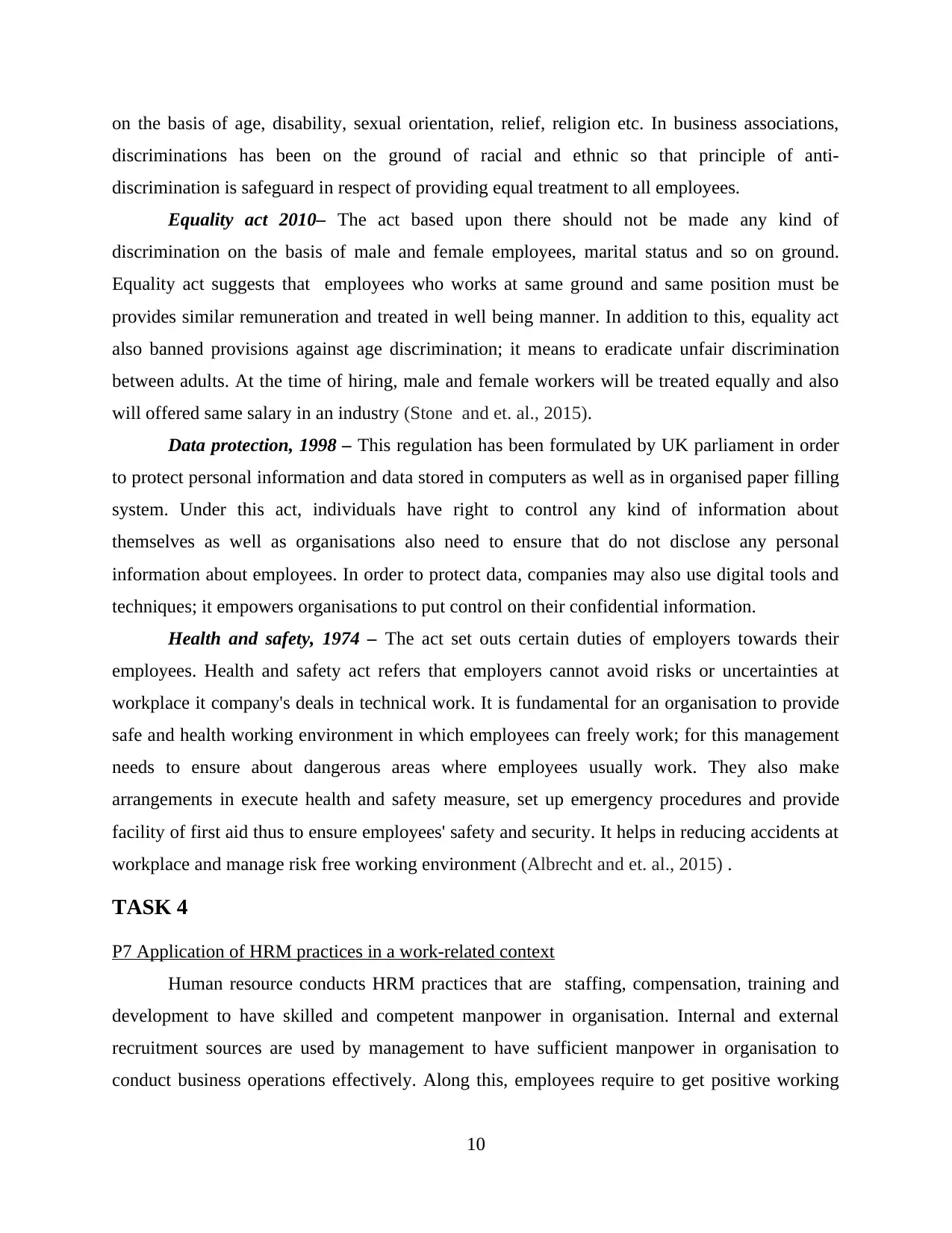
on the basis of age, disability, sexual orientation, relief, religion etc. In business associations,
discriminations has been on the ground of racial and ethnic so that principle of anti-
discrimination is safeguard in respect of providing equal treatment to all employees.
Equality act 2010– The act based upon there should not be made any kind of
discrimination on the basis of male and female employees, marital status and so on ground.
Equality act suggests that employees who works at same ground and same position must be
provides similar remuneration and treated in well being manner. In addition to this, equality act
also banned provisions against age discrimination; it means to eradicate unfair discrimination
between adults. At the time of hiring, male and female workers will be treated equally and also
will offered same salary in an industry (Stone and et. al., 2015).
Data protection, 1998 – This regulation has been formulated by UK parliament in order
to protect personal information and data stored in computers as well as in organised paper filling
system. Under this act, individuals have right to control any kind of information about
themselves as well as organisations also need to ensure that do not disclose any personal
information about employees. In order to protect data, companies may also use digital tools and
techniques; it empowers organisations to put control on their confidential information.
Health and safety, 1974 – The act set outs certain duties of employers towards their
employees. Health and safety act refers that employers cannot avoid risks or uncertainties at
workplace it company's deals in technical work. It is fundamental for an organisation to provide
safe and health working environment in which employees can freely work; for this management
needs to ensure about dangerous areas where employees usually work. They also make
arrangements in execute health and safety measure, set up emergency procedures and provide
facility of first aid thus to ensure employees' safety and security. It helps in reducing accidents at
workplace and manage risk free working environment (Albrecht and et. al., 2015) .
TASK 4
P7 Application of HRM practices in a work-related context
Human resource conducts HRM practices that are staffing, compensation, training and
development to have skilled and competent manpower in organisation. Internal and external
recruitment sources are used by management to have sufficient manpower in organisation to
conduct business operations effectively. Along this, employees require to get positive working
10
discriminations has been on the ground of racial and ethnic so that principle of anti-
discrimination is safeguard in respect of providing equal treatment to all employees.
Equality act 2010– The act based upon there should not be made any kind of
discrimination on the basis of male and female employees, marital status and so on ground.
Equality act suggests that employees who works at same ground and same position must be
provides similar remuneration and treated in well being manner. In addition to this, equality act
also banned provisions against age discrimination; it means to eradicate unfair discrimination
between adults. At the time of hiring, male and female workers will be treated equally and also
will offered same salary in an industry (Stone and et. al., 2015).
Data protection, 1998 – This regulation has been formulated by UK parliament in order
to protect personal information and data stored in computers as well as in organised paper filling
system. Under this act, individuals have right to control any kind of information about
themselves as well as organisations also need to ensure that do not disclose any personal
information about employees. In order to protect data, companies may also use digital tools and
techniques; it empowers organisations to put control on their confidential information.
Health and safety, 1974 – The act set outs certain duties of employers towards their
employees. Health and safety act refers that employers cannot avoid risks or uncertainties at
workplace it company's deals in technical work. It is fundamental for an organisation to provide
safe and health working environment in which employees can freely work; for this management
needs to ensure about dangerous areas where employees usually work. They also make
arrangements in execute health and safety measure, set up emergency procedures and provide
facility of first aid thus to ensure employees' safety and security. It helps in reducing accidents at
workplace and manage risk free working environment (Albrecht and et. al., 2015) .
TASK 4
P7 Application of HRM practices in a work-related context
Human resource conducts HRM practices that are staffing, compensation, training and
development to have skilled and competent manpower in organisation. Internal and external
recruitment sources are used by management to have sufficient manpower in organisation to
conduct business operations effectively. Along this, employees require to get positive working
10
Paraphrase This Document
Need a fresh take? Get an instant paraphrase of this document with our AI Paraphraser
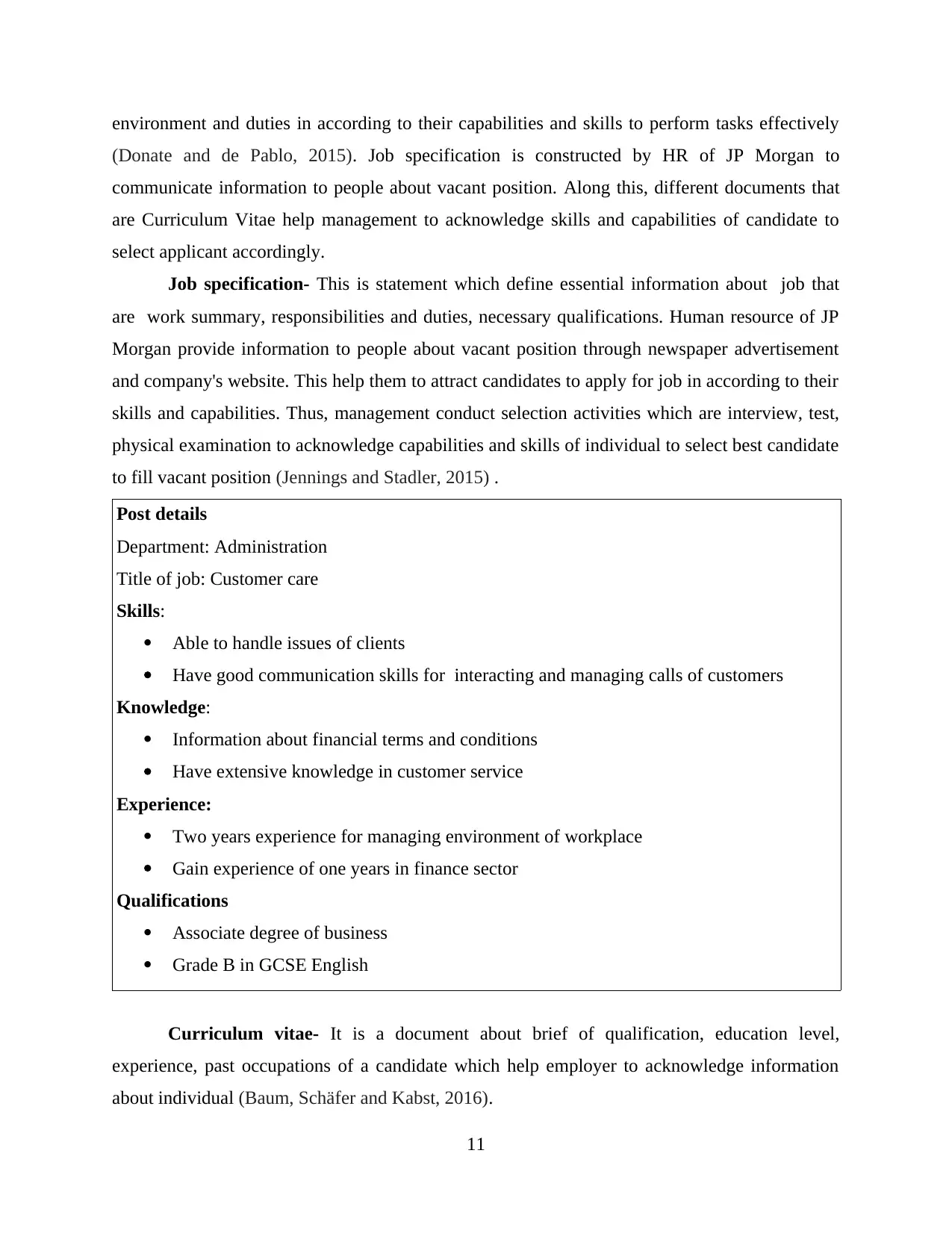
environment and duties in according to their capabilities and skills to perform tasks effectively
(Donate and de Pablo, 2015). Job specification is constructed by HR of JP Morgan to
communicate information to people about vacant position. Along this, different documents that
are Curriculum Vitae help management to acknowledge skills and capabilities of candidate to
select applicant accordingly.
Job specification- This is statement which define essential information about job that
are work summary, responsibilities and duties, necessary qualifications. Human resource of JP
Morgan provide information to people about vacant position through newspaper advertisement
and company's website. This help them to attract candidates to apply for job in according to their
skills and capabilities. Thus, management conduct selection activities which are interview, test,
physical examination to acknowledge capabilities and skills of individual to select best candidate
to fill vacant position (Jennings and Stadler, 2015) .
Post details
Department: Administration
Title of job: Customer care
Skills:
Able to handle issues of clients
Have good communication skills for interacting and managing calls of customers
Knowledge:
Information about financial terms and conditions
Have extensive knowledge in customer service
Experience:
Two years experience for managing environment of workplace
Gain experience of one years in finance sector
Qualifications
Associate degree of business
Grade B in GCSE English
Curriculum vitae- It is a document about brief of qualification, education level,
experience, past occupations of a candidate which help employer to acknowledge information
about individual (Baum, Schäfer and Kabst, 2016).
11
(Donate and de Pablo, 2015). Job specification is constructed by HR of JP Morgan to
communicate information to people about vacant position. Along this, different documents that
are Curriculum Vitae help management to acknowledge skills and capabilities of candidate to
select applicant accordingly.
Job specification- This is statement which define essential information about job that
are work summary, responsibilities and duties, necessary qualifications. Human resource of JP
Morgan provide information to people about vacant position through newspaper advertisement
and company's website. This help them to attract candidates to apply for job in according to their
skills and capabilities. Thus, management conduct selection activities which are interview, test,
physical examination to acknowledge capabilities and skills of individual to select best candidate
to fill vacant position (Jennings and Stadler, 2015) .
Post details
Department: Administration
Title of job: Customer care
Skills:
Able to handle issues of clients
Have good communication skills for interacting and managing calls of customers
Knowledge:
Information about financial terms and conditions
Have extensive knowledge in customer service
Experience:
Two years experience for managing environment of workplace
Gain experience of one years in finance sector
Qualifications
Associate degree of business
Grade B in GCSE English
Curriculum vitae- It is a document about brief of qualification, education level,
experience, past occupations of a candidate which help employer to acknowledge information
about individual (Baum, Schäfer and Kabst, 2016).
11
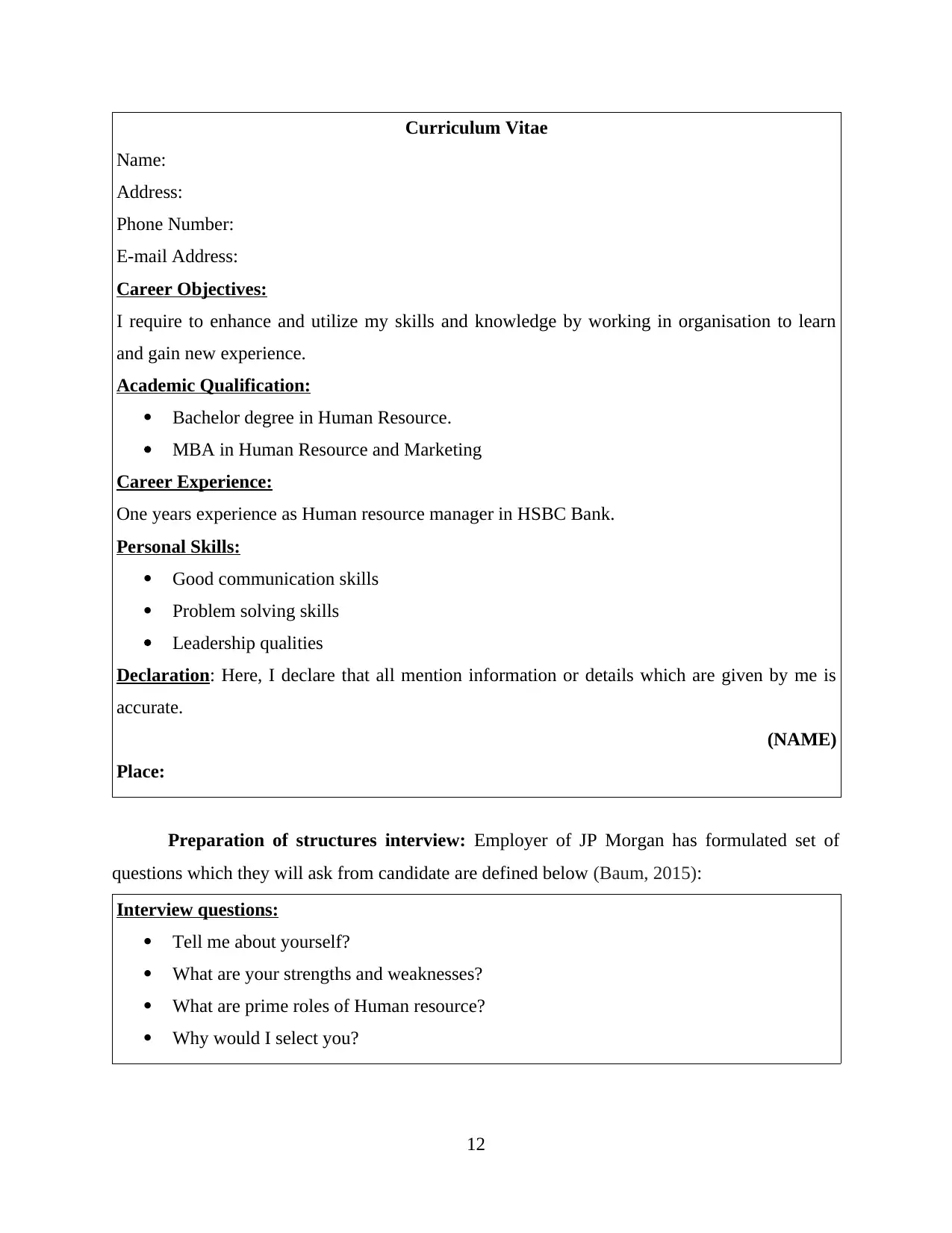
Curriculum Vitae
Name:
Address:
Phone Number:
E-mail Address:
Career Objectives:
I require to enhance and utilize my skills and knowledge by working in organisation to learn
and gain new experience.
Academic Qualification:
Bachelor degree in Human Resource.
MBA in Human Resource and Marketing
Career Experience:
One years experience as Human resource manager in HSBC Bank.
Personal Skills:
Good communication skills
Problem solving skills
Leadership qualities
Declaration: Here, I declare that all mention information or details which are given by me is
accurate.
(NAME)
Place:
Preparation of structures interview: Employer of JP Morgan has formulated set of
questions which they will ask from candidate are defined below (Baum, 2015):
Interview questions:
Tell me about yourself?
What are your strengths and weaknesses?
What are prime roles of Human resource?
Why would I select you?
12
Name:
Address:
Phone Number:
E-mail Address:
Career Objectives:
I require to enhance and utilize my skills and knowledge by working in organisation to learn
and gain new experience.
Academic Qualification:
Bachelor degree in Human Resource.
MBA in Human Resource and Marketing
Career Experience:
One years experience as Human resource manager in HSBC Bank.
Personal Skills:
Good communication skills
Problem solving skills
Leadership qualities
Declaration: Here, I declare that all mention information or details which are given by me is
accurate.
(NAME)
Place:
Preparation of structures interview: Employer of JP Morgan has formulated set of
questions which they will ask from candidate are defined below (Baum, 2015):
Interview questions:
Tell me about yourself?
What are your strengths and weaknesses?
What are prime roles of Human resource?
Why would I select you?
12
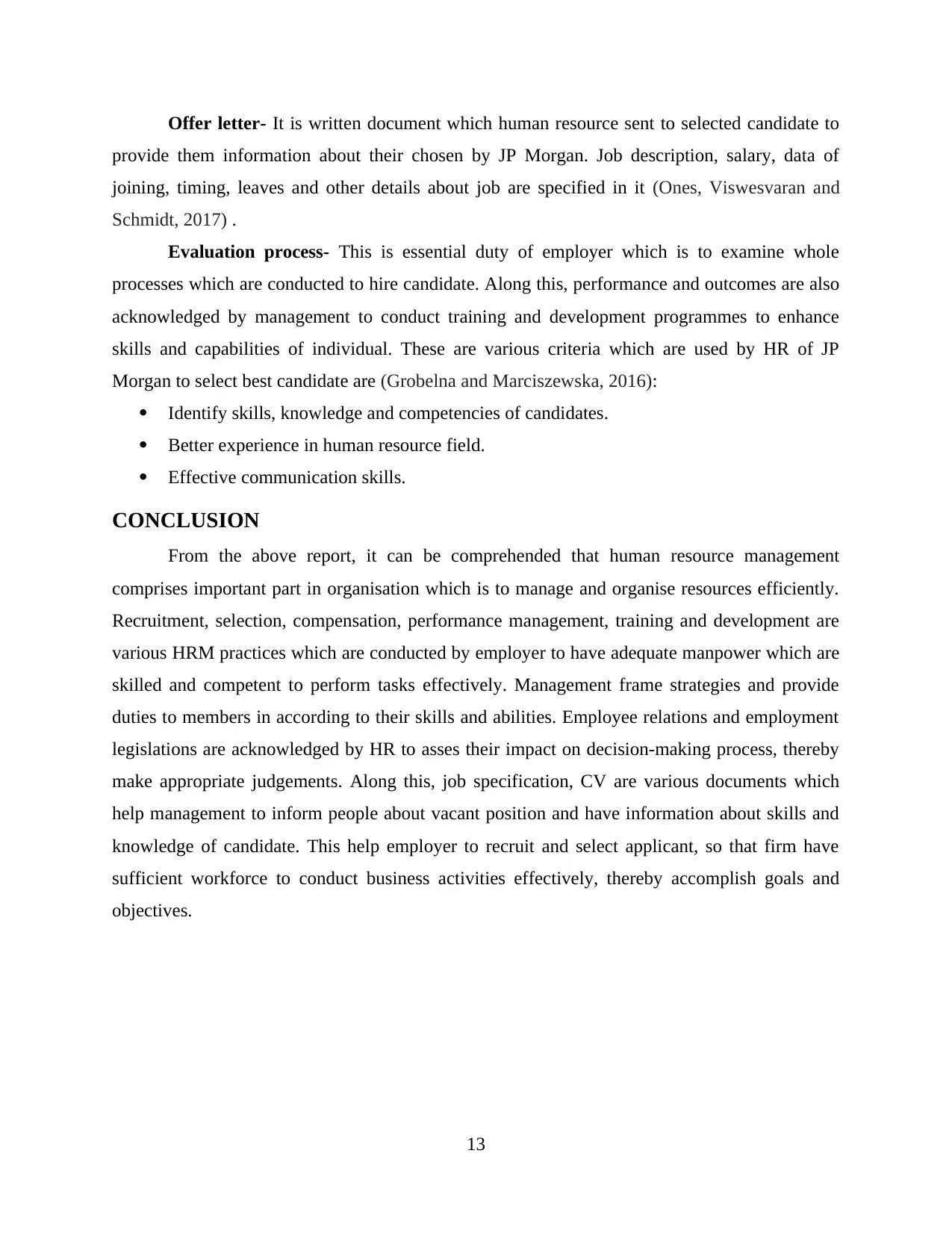
Offer letter- It is written document which human resource sent to selected candidate to
provide them information about their chosen by JP Morgan. Job description, salary, data of
joining, timing, leaves and other details about job are specified in it (Ones, Viswesvaran and
Schmidt, 2017) .
Evaluation process- This is essential duty of employer which is to examine whole
processes which are conducted to hire candidate. Along this, performance and outcomes are also
acknowledged by management to conduct training and development programmes to enhance
skills and capabilities of individual. These are various criteria which are used by HR of JP
Morgan to select best candidate are (Grobelna and Marciszewska, 2016):
Identify skills, knowledge and competencies of candidates.
Better experience in human resource field.
Effective communication skills.
CONCLUSION
From the above report, it can be comprehended that human resource management
comprises important part in organisation which is to manage and organise resources efficiently.
Recruitment, selection, compensation, performance management, training and development are
various HRM practices which are conducted by employer to have adequate manpower which are
skilled and competent to perform tasks effectively. Management frame strategies and provide
duties to members in according to their skills and abilities. Employee relations and employment
legislations are acknowledged by HR to asses their impact on decision-making process, thereby
make appropriate judgements. Along this, job specification, CV are various documents which
help management to inform people about vacant position and have information about skills and
knowledge of candidate. This help employer to recruit and select applicant, so that firm have
sufficient workforce to conduct business activities effectively, thereby accomplish goals and
objectives.
13
provide them information about their chosen by JP Morgan. Job description, salary, data of
joining, timing, leaves and other details about job are specified in it (Ones, Viswesvaran and
Schmidt, 2017) .
Evaluation process- This is essential duty of employer which is to examine whole
processes which are conducted to hire candidate. Along this, performance and outcomes are also
acknowledged by management to conduct training and development programmes to enhance
skills and capabilities of individual. These are various criteria which are used by HR of JP
Morgan to select best candidate are (Grobelna and Marciszewska, 2016):
Identify skills, knowledge and competencies of candidates.
Better experience in human resource field.
Effective communication skills.
CONCLUSION
From the above report, it can be comprehended that human resource management
comprises important part in organisation which is to manage and organise resources efficiently.
Recruitment, selection, compensation, performance management, training and development are
various HRM practices which are conducted by employer to have adequate manpower which are
skilled and competent to perform tasks effectively. Management frame strategies and provide
duties to members in according to their skills and abilities. Employee relations and employment
legislations are acknowledged by HR to asses their impact on decision-making process, thereby
make appropriate judgements. Along this, job specification, CV are various documents which
help management to inform people about vacant position and have information about skills and
knowledge of candidate. This help employer to recruit and select applicant, so that firm have
sufficient workforce to conduct business activities effectively, thereby accomplish goals and
objectives.
13
Secure Best Marks with AI Grader
Need help grading? Try our AI Grader for instant feedback on your assignments.

REFERENCES
Books and Journals
Cascio, W., 2018. Managing human resources. McGraw-Hill Education.
Bratton, J. and Gold, J., 2017. Human resource management: theory and practice. Palgrave.
Brewster, C. and Hegewisch, A. eds., 2017. Policy and practice in European human resource
management: The Price Waterhouse Cranfield survey. Taylor & Francis.
Chelladurai, P. and Kerwin, S., 2017. Human resource management in sport and recreation.
Human Kinetics.
Marchington, M. and et. al., 2016. Human resource management at work. Kogan Page
Publishers.
Albrecht, S. L. and et. al., 2015. Employee engagement, human resource management practices
and competitive advantage: An integrated approach. Journal of Organizational
Effectiveness: People and Performance. 2(1). pp.7-35.
Stone, D. L. and et. al., 2015. The influence of technology on the future of human resource
management. Human Resource Management Review. 25(2). pp.216-231.
Shen, J. and Benson, J., 2016. When CSR is a social norm: How socially responsible human
resource management affects employee work behavior. Journal of Management. 42(6).
pp.1723-1746.
Abdullah, L. and Zulkifli, N., 2015. Integration of fuzzy AHP and interval type-2 fuzzy
DEMATEL: An application to human resource management. Expert Systems with
Applications. 42(9). pp.4397-4409.
Grobelna, A. and Marciszewska, B., 2016, April. Work motivation of tourism and hospitality
students: implications for human resource management. In Proceedings of the 8th
European Conference on Intellectual Capital, ECIC. pp. 95-103.
Ones, D. S., Viswesvaran, C. and Schmidt, F. L., 2017. Realizing the full potential of
psychometric meta-analysis for a cumulative science and practice of human resource
management. Human Resource Management Review. 27(1). pp.201-215.
Baum, T., 2015. Human resources in tourism: Still waiting for change?–A 2015 reprise. Tourism
Management. 50. pp.204-212.
Baum, M., Schäfer, M. and Kabst, R., 2016. Modeling the Impact of Advertisement‐Image
Congruity on Applicant Attraction. Human Resource Management. 55(1). pp.7-24.
Jennings, B. and Stadler, R., 2015. Resource management in clouds: Survey and research
challenges. Journal of Network and Systems Management. 23(3). pp.567-619.
Donate, M. J. and de Pablo, J. D. S., 2015. The role of knowledge-oriented leadership in
knowledge management practices and innovation. Journal of Business Research. 68(2).
pp.360-370.
Daley, D. M., 2012. Strategic human resources management.Public Personnel Management,
pp.120-125.Guest, D. E., Paauwe, J. and Wright, P. eds., 2012. HRM and performance:
Achievements and challenges. John Wiley & Sons.
Gurkov, I., Zelenova, O. and Saidov, Z., 2012. Mutation of HRM practices in Russia: an
application of CRANET methodology. The International Journal of Human Resource
Management. 23(7). pp. 1289-1302.Park, H. J., and et. al., 2014. MNC knowledge
transfer, subsidiary absorptive capacity and HRM. Journal of International Business
Studies. 45(1). pp. 38-51.
14
Books and Journals
Cascio, W., 2018. Managing human resources. McGraw-Hill Education.
Bratton, J. and Gold, J., 2017. Human resource management: theory and practice. Palgrave.
Brewster, C. and Hegewisch, A. eds., 2017. Policy and practice in European human resource
management: The Price Waterhouse Cranfield survey. Taylor & Francis.
Chelladurai, P. and Kerwin, S., 2017. Human resource management in sport and recreation.
Human Kinetics.
Marchington, M. and et. al., 2016. Human resource management at work. Kogan Page
Publishers.
Albrecht, S. L. and et. al., 2015. Employee engagement, human resource management practices
and competitive advantage: An integrated approach. Journal of Organizational
Effectiveness: People and Performance. 2(1). pp.7-35.
Stone, D. L. and et. al., 2015. The influence of technology on the future of human resource
management. Human Resource Management Review. 25(2). pp.216-231.
Shen, J. and Benson, J., 2016. When CSR is a social norm: How socially responsible human
resource management affects employee work behavior. Journal of Management. 42(6).
pp.1723-1746.
Abdullah, L. and Zulkifli, N., 2015. Integration of fuzzy AHP and interval type-2 fuzzy
DEMATEL: An application to human resource management. Expert Systems with
Applications. 42(9). pp.4397-4409.
Grobelna, A. and Marciszewska, B., 2016, April. Work motivation of tourism and hospitality
students: implications for human resource management. In Proceedings of the 8th
European Conference on Intellectual Capital, ECIC. pp. 95-103.
Ones, D. S., Viswesvaran, C. and Schmidt, F. L., 2017. Realizing the full potential of
psychometric meta-analysis for a cumulative science and practice of human resource
management. Human Resource Management Review. 27(1). pp.201-215.
Baum, T., 2015. Human resources in tourism: Still waiting for change?–A 2015 reprise. Tourism
Management. 50. pp.204-212.
Baum, M., Schäfer, M. and Kabst, R., 2016. Modeling the Impact of Advertisement‐Image
Congruity on Applicant Attraction. Human Resource Management. 55(1). pp.7-24.
Jennings, B. and Stadler, R., 2015. Resource management in clouds: Survey and research
challenges. Journal of Network and Systems Management. 23(3). pp.567-619.
Donate, M. J. and de Pablo, J. D. S., 2015. The role of knowledge-oriented leadership in
knowledge management practices and innovation. Journal of Business Research. 68(2).
pp.360-370.
Daley, D. M., 2012. Strategic human resources management.Public Personnel Management,
pp.120-125.Guest, D. E., Paauwe, J. and Wright, P. eds., 2012. HRM and performance:
Achievements and challenges. John Wiley & Sons.
Gurkov, I., Zelenova, O. and Saidov, Z., 2012. Mutation of HRM practices in Russia: an
application of CRANET methodology. The International Journal of Human Resource
Management. 23(7). pp. 1289-1302.Park, H. J., and et. al., 2014. MNC knowledge
transfer, subsidiary absorptive capacity and HRM. Journal of International Business
Studies. 45(1). pp. 38-51.
14
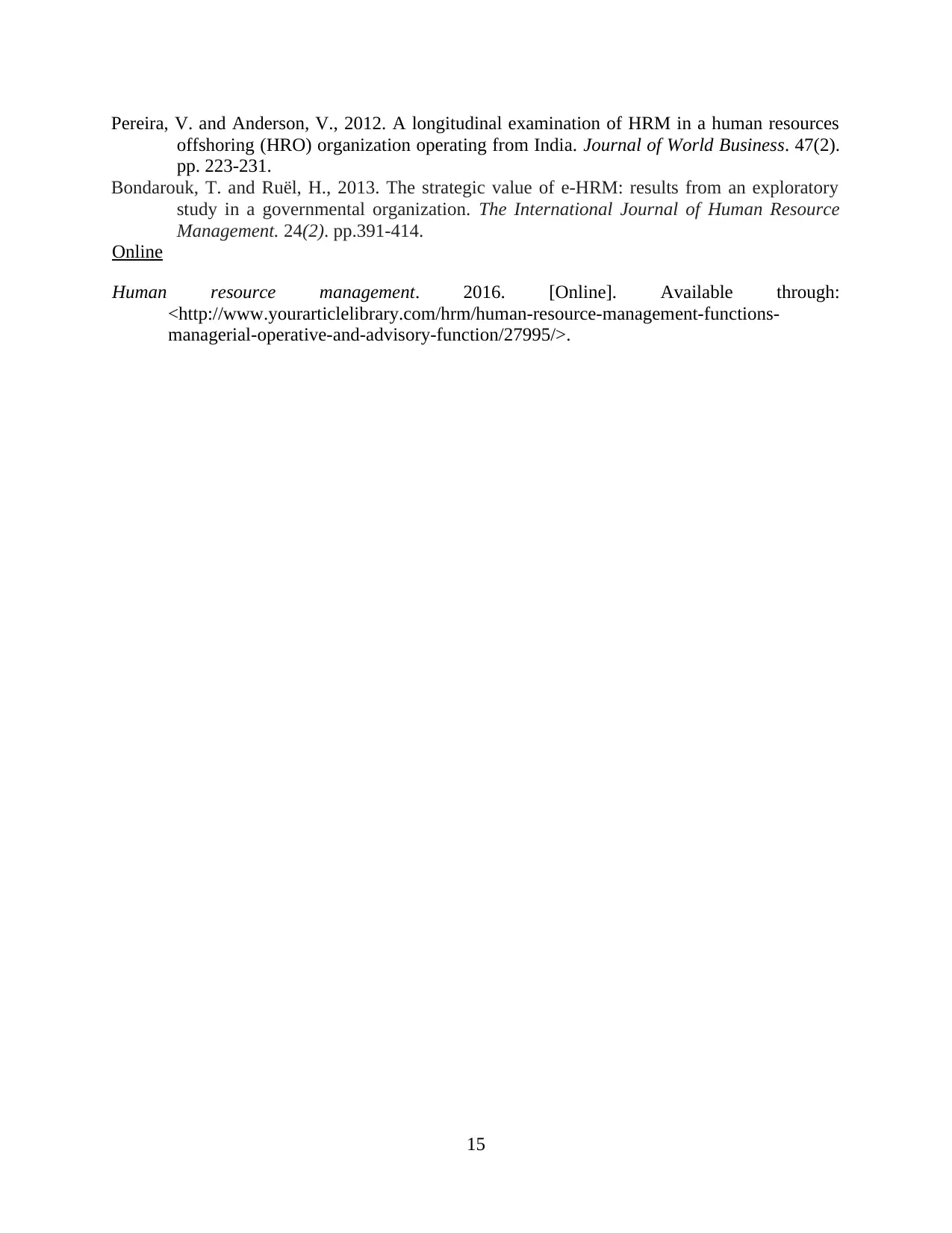
Pereira, V. and Anderson, V., 2012. A longitudinal examination of HRM in a human resources
offshoring (HRO) organization operating from India. Journal of World Business. 47(2).
pp. 223-231.
Bondarouk, T. and Ruël, H., 2013. The strategic value of e-HRM: results from an exploratory
study in a governmental organization. The International Journal of Human Resource
Management. 24(2). pp.391-414.
Online
Human resource management. 2016. [Online]. Available through:
<http://www.yourarticlelibrary.com/hrm/human-resource-management-functions-
managerial-operative-and-advisory-function/27995/>.
15
offshoring (HRO) organization operating from India. Journal of World Business. 47(2).
pp. 223-231.
Bondarouk, T. and Ruël, H., 2013. The strategic value of e-HRM: results from an exploratory
study in a governmental organization. The International Journal of Human Resource
Management. 24(2). pp.391-414.
Online
Human resource management. 2016. [Online]. Available through:
<http://www.yourarticlelibrary.com/hrm/human-resource-management-functions-
managerial-operative-and-advisory-function/27995/>.
15
1 out of 18
Related Documents
Your All-in-One AI-Powered Toolkit for Academic Success.
+13062052269
info@desklib.com
Available 24*7 on WhatsApp / Email
![[object Object]](/_next/static/media/star-bottom.7253800d.svg)
Unlock your academic potential
© 2024 | Zucol Services PVT LTD | All rights reserved.





